Commission Implementing Regulation (EU) No 923/2012
of 26 September 2012
laying down the common rules of the air and operational provisions regarding services and procedures in air navigation and amending Implementing Regulation (EU) No 1035/2011 and Regulations (EC) No 1265/2007, (EC) No 1794/2006, (EC) No 730/2006, (EC) No 1033/2006 and (EU) No 255/2010
(Text with EEA relevance)
Commission Implementing Regulation (EU) No 923/2012
of 26 September 2012
laying down the common rules of the air and operational provisions regarding services and procedures in air navigation and amending Implementing Regulation (EU) No 1035/2011 and Regulations (EC) No 1265/2007, (EC) No 1794/2006, (EC) No 730/2006, (EC) No 1033/2006 and (EU) No 255/2010
(Text with EEA relevance)
THE EUROPEAN COMMISSION,
Having regard to the Treaty on the Functioning of the European Union,
Having regard to Regulation (EC) No 551/2004 of the European Parliament and of the Council of 10 March 2004 on the organisation and use of the airspace in the single European sky (the airspace Regulation), and in particular Article 4(a) and (b) thereof,
Having regard to Regulation (EC) No 216/2008 of the European Parliament and of the Council of 20 February 2008 on common rules in the field of civil aviation and establishing a European Aviation Safety Agency (the EASA Basic Regulation), and in particular Articles 8 and 8b and Annex Vb thereto,
Whereas:
(1) Pursuant to Regulation (EC) No 551/2004 and Regulation (EC) No 216/2008, the Commission is required to adopt implementing rules in order to adopt appropriate provisions on rules of the air based upon Standards and recommended practices of the International Civil Aviation Organisation (ICAO), and to harmonise the application of the ICAO airspace classification, with the aim to ensure the seamless provision of safe and efficient air traffic services within the single European sky.
(2) Eurocontrol has been mandated in accordance with Article 8(1) of Regulation (EC) No 549/2004 of the European Parliament and the Council of 10 March 2004 laying down the framework for the creation of the single European sky to assist the Commission in the development of implementing rules which lay down appropriate provisions on rules of the air based upon ICAO Standards and recommended practices, and harmonise the application of the ICAO airspace classification.
(3) In accordance with Articles 1(3) and 13 of Regulation (EC) No 549/2004 and Article 2 of Regulation (EC) No 216/2008, the single European sky initiative should assist the Member States in fulfilling their obligations under the 1944 Chicago Convention on International Civil Aviation (hereafter the Chicago Convention) by providing for common interpretation and implementation.
(4) The objective of Regulation (EC) No 551/2004 is to support the concept of a more integrated operating airspace within the context of the common transport policy, and to establish common procedures for design, planning and management while ensuring the efficient and safe performance of air traffic management. This objective is particularly relevant for the rapid implementation of functional airspace blocks in the single European sky.
(5) The outcome of the work undertaken by the joint group created by the Commission, Eurocontrol and ICAO, which charted the national differences filed by Member States relating to ICAO Standards dealing with rules of the air and related provisions for air navigation services, supports the need for standardisation of common rules and differences with respect to the single European sky.
(6) In order to ensure safe, efficient and expeditious international air traffic and to support the establishment of functional airspace blocks, all participants in the single European sky should adhere to a common set of rules. Furthermore, a key enabler of safe cross-border operations is the creation of a transparent regulatory system, where the actors can be provided a legal certainty and predictability. To this end, standardised rules of the air and related operational provisions regarding services and procedures in air navigation should be established, and be supplemented, where appropriate, with guidance material and/or acceptable means of compliance.
(7) To achieve those objectives, only commonly agreed European differences should be notified to ICAO by the Member States on areas which are covered by Union law. Those differences should be established and monitored through a permanent process.
(8) Member States that have adopted additional provisions complementing an ICAO standard, should, if they are still considered necessary and provided such additional provisions do not constitute a difference under the Chicago Convention or against existing Union law, continue to apply such provisions until they are addressed by appropriate Union provisions.
(9) The application of this Regulation should be without prejudice to the Member States’ obligations and rights over the high seas, in accordance with Article 12 of the Chicago Convention, and in particular with Annex 2 to the Chicago Convention, as well as the obligations of Member States and the Union under the United Nations Convention on the Law of the Sea and the obligations of Member States under the Convention on the International Regulations for Preventing Collisions at Sea, 1972.
(10) In accordance with Article 1(2) of the framework Regulation (EC) No 549/2004, the regulatory framework for the creation of the single European sky does not cover military operations and training.
(11) The existing process for amending ICAO Standards and recommended practices within the framework of the Chicago Convention is not addressed by this Regulation.
(12) The extension of the competence of EASA to include air traffic management safety requires consistency between the development of implementing rules under Regulations (EC) No 551/2004 and (EC) No 216/2008.
(13) In order to ensure consistency between the transposition of provisions of Annex 2 to the Chicago Convention set out in this Regulation and the future provisions stemming from other annexes to the Chicago Convention, which will be included in the next stages of work as well as the implementation of future Union rules, the initial provisions should be revisited where necessary.
(14) Where necessary, other Union legislation should be updated to refer to this Regulation,
HAS ADOPTED THIS REGULATION:
Article 1
Subject matter and scope
1.The objective of this Regulation is to establish the common rules of the air and operational provisions regarding services and procedures in air navigation that shall be applicable to general air traffic within the scope of Regulation (EC) No 551/2004.
2.This Regulation shall apply in particular to airspace users and aircraft engaged in general air traffic:
- operating into, within or out of Gibraltar ;
- bearing the nationality and registration marks of Gibraltar, and operating in any airspace to the extent that they do not conflict with the rules published by the country having jurisdiction over the territory overflown.
3 . This Regulation shall also apply to the competent authority, air navigation service providers, aerodrome operators and ground personnel engaged in aircraft operations.
4 . This Regulation shall not apply to model aircraft and toy aircraft. However, the Minister with responsibility for Civil Aviation must take such steps as the Minister with responsibility for Civil Aviation considers appropriate to ensure that model aircraft and toy aircraft are operated in such a manner as to minimise hazards related to civil aviation safety, to persons, property or other aircraft.
Article 2
Definitions
For the purpose of this Regulation the following definitions shall apply:
- preventing collisions:
- take-off alternate:an alternate aerodrome at which an aircraft would be able to land should this become necessary shortly after take-off and it is not possible to use the aerodrome of departure;
- en-route alternate:an alternate aerodrome at which an aircraft would be able to land in the event that a diversion becomes necessary while en route;
- destination alternate:an alternate aerodrome at which an aircraft would be able to land should it become either impossible or inadvisable to land at the aerodrome of intended landing;
- ‘Data link-automatic terminal information service (D-ATIS)’ means the provision of ATIS via data link;
- ‘Voice-automatic terminal information service (Voice-ATIS)’ means the provision of ATIS by means of continuous and repetitive voice broadcasts;
- a two-dimensional (2D) instrument approach operation, using lateral navigation guidance only; and
- a three-dimensional (3D) instrument approach operation, using both lateral and vertical navigation guidance;
- non-precision approach (NPA) procedure. An instrument approach procedure designed for 2D instrument approach operations Type A;
- approach procedure with vertical guidance (APV). A performance-based navigation (PBN) instrument approach procedure designed for 3D instrument approach operations Type A;
- precision approach (PA) procedure. An instrument approach procedure based on navigation systems (ILS, MLS, GLS and SBAS Cat I) designed for 3D instrument approach operations Type A or B;
- are located on an area intended for the surface movement of aircraft; or
- extend above a defined surface intended to protect aircraft in flight; or
- stand outside those defined surfaces and that have been assessed as being a hazard to air navigation;
- constitutes a direct hazard to the user or endangers the lives, health or welfare of others; and/or
- causes or worsens an occupational, social, mental or physical problem or disorder;
- Aircraft stand taxilane means a portion of an apron designated as a taxiway and intended to provide access to aircraft stands only.
- Apron taxiway means a portion of a taxiway system located on an apron and intended to provide a through taxi route across the apron.
- Rapid exit taxiway means a taxiway connected to a runway at an acute angle and designed to allow landing aeroplanes to turn off at higher speeds than are achieved on other exit taxiways thereby minimising runway occupancy times;
- for IFR flights, the estimated time required from take-off to arrive over that designated point, defined by reference to navigation aids, from which it is intended that an instrument approach procedure will be commenced, or, if no navigation aid is associated with the destination aerodrome, to arrive over the destination aerodrome;
- for VFR flights, the estimated time required from take-off to arrive over the destination aerodrome;
- the greatest distance at which a black object of suitable dimensions, situated near the ground, can be seen and recognised when observed against a bright background;
- the greatest distance at which lights in the vicinity of 1 000 candelas can be seen and identified against an unlit background;
Article 3
Compliance
The competent authority shall ensure compliance with the common rules and provisions set out in the Annex to this Regulation without prejudice to the flexibility provisions contained in Article 14 of the Regulation (EC) No 216/2008 and the safeguards contained in Article 13 of Regulation (EC) No 549/2004.
Article 4
Exemptions for special operations
1 . The competent authority may, either on its own initiative or based on applications by the entities concerned, grant exemptions to individual entities or to categories of entities from any of the requirements of this Regulation for the following activities of public interest and for the training necessary to carry out those activities safely:
- police and customs missions;
- traffic surveillance and pursuit missions;
- environmental control missions conducted by, or on behalf of public authorities;
- search and rescue;
- medical flights;
- evacuations;
- fire fighting;
- exemptions required to ensure the security of flights by heads of State, Ministers and comparable State functionaries.
2.Omitted
3.This Article is without prejudice to Article 3 and may be applied in the cases where the activities listed under paragraph 1, cannot be carried out as operational air traffic or where they otherwise may not benefit from the flexibility provisions contained in this Regulation.
This Article shall also be without prejudice to helicopter operating minima contained in the specific approvals granted by the competent authority, pursuant to Annex V to Commission Regulation (EU) No 965/2012 .
Article 5
Omitted
Monitoring of amendments
1.The competent authority must:
- ... ensure that any amendments adopted under the framework of the Chicago Convention which are of relevance with respect to the scope of this Regulation are monitored and analysed; and
- where necessary, ... develop proposals for amendments to the Annex to this Regulation.
2.The provisions of ... Article 7 regarding amendments to the Annex shall apply as appropriate.
Article 7
Amendments to the Annex
1.The Minister with responsibility for Civil Aviation may by regulations amend the Annex to this Regulation.
2.The amendments referred to in paragraph 1 may include, but shall not be limited to, amendments required to ensure consistency of legal provisions during the future extension of this Regulation to contain the relevant provisions of other ICAO annexes and documents than Annex 2 or changes stemming from updates of those ICAO annexes and documents themselves or from changes to any relevant European Union Regulations.
3.Regulations under paragraph 1—
- may make different provision for different purposes;
- may make transitional, transitory or saving provision;
- may make consequential, incidental or supplementary provision.
Omitted
Article 9
Omitted
Article 10
Amendments to Regulations (EC) No 730/2006, (EC) No 1033/2006, (EC) No 1794/2006, (EC) No 1265/2007, (EU) No 255/2010 and Implementing Regulation (EU) No 1035/2011
1.Omitted
2.Regulation (EC) No 1033/2006 is amended as follows:
- Article 2(2), point 8, shall be replaced by the following:
(b) Article 3(1) shall be replaced by the following:
‘1.The provisions specified in the Annex shall apply to the submission, acceptance and distribution of flight plans for every flight subject to this Regulation and to all changes to a key item in a flight plan in the pre-flight phase in accordance with this Regulation.’;
(c) the heading and first indent of the Annex shall be replaced by the following:
‘Provisions referred to in Article 3(1)
1.Section 4 of Commission Implementing Regulation (EU) No 923/2012.’.
3.Omitted
4.Omitted
5.Regulation (EU) No 255/2010 is amended as follows:
- Article 2(3) shall be replaced by the following:
6.Implementing Regulation (EU) No 1035/2011 is amended as follows:
- the reference in Annex II, point 4(a), to ‘Annex 2 on rules of the air in its 10th edition of July 2005’ shall be replaced by a reference to ‘Implementing Regulation (EU) No 923/2012’;
- the reference in Annex II, point 4(c), to ‘Annex 11 on air traffic services in its 13th edition of July 2001, including all amendments up to No 47-B’ shall be amended by adding at the end of that sentence ‘and Implementing Regulation (EU) No 923/2012 as applicable.’;
- the reference in Annex III, point 2(b), to ‘Annex 11 on air traffic services in its 13th edition of July 2001, including all amendments up to No 47-B’ shall be amended by adding at the end of that sentence ‘and Implementing Regulation (EU) No 923/2012 as applicable;’
Article 11
Omitted
ANNEX
RULES OF THE AIR
SECTION 1
Flight over the high seas
General
- For flight over the high seas, the rules specified in Annex 2 to the Chicago Convention shall apply without exception. For the purposes of continuity and seamless operation of air traffic services ..., the provisions of Annex 11 to the Chicago Convention may be applied in airspace over high seas in a manner that is consistent with how those provisions are applied over the territory of Gibraltar. This shall be without prejudice to the operations of State Aircraft under Article 3 of the Chicago Convention. This shall also be without prejudice to the responsibilities of Gibraltar to ensure that aircraft operations within the Flight Information Regions within which Gibraltar is responsible for the provision of air traffic services in accordance with ICAO regional air navigation agreements are undertaken in a safe, expeditious and efficient manner.
- For those parts of the high seas where Gibraltar has accepted, pursuant to an ICAO regional air navigation agreement, the responsibility of providing air traffic services, the Minister with responsibility for Civil Aviation shall designate the ATS provider for providing those services.
SECTION 2
Applicability and compliance
SERA.2001
Subject
Without prejudice to SERA.1001 above, this annex addresses, in accordance with Article 1, in particular airspace users and aircraft:
- operating into, within or out of Gibraltar;
- bearing the nationality and registration marks of Gibraltar, and operating in any airspace to the extent that they do not conflict with the rules published by the State having jurisdiction over the territory overflown.
This annex addresses also the actions of the competent authority, Air Navigation Service Providers (ANSP), aerodrome operators and the relevant ground personnel engaged in aircraft operations.
SERA.2005
Compliance with the rules of the air
The operation of an aircraft either in flight, on the movement area of an aerodrome or at an operating site shall be in compliance with the general rules, the applicable local provisions and, in addition, when in flight, either with:
- the visual flight rules; or
- the instrument flight rules.
SERA.2010
Responsibilities
- Responsibility of the pilot-in-command
The pilot-in-command of an aircraft shall, whether manipulating the controls or not, be responsible for the operation of the aircraft in accordance with this Regulation, except that the pilot-in-command may depart from these rules in circumstances that render such departure absolutely necessary in the interests of safety.
(b) Pre-flight action
Before beginning a flight, the pilot-in-command of an aircraft shall become familiar with all available information appropriate to the intended operation. Pre-flight action for flights away from the vicinity of an aerodrome, and for all IFR flights, shall include a careful study of available current weather reports and forecasts, taking into consideration fuel requirements and an alternative course of action if the flight cannot be completed as planned.
SERA.2015
Authority of pilot-in-command of an aircraft
The pilot-in-command of an aircraft shall have final authority as to the disposition of the aircraft while in command.
SERA.2020
Problematic use of psychoactive substances
No person whose function is critical to the safety of aviation (safety-sensitive personnel) shall undertake that function while under the influence of any psychoactive substance, by reason of which human performance is impaired. No such person shall engage in any kind of problematic use of substances.
SECTION 3
General rules and collision avoidance
CHAPTER 1
Protection of persons and property
SERA.3101
Negligent or reckless operation of aircraft
An aircraft shall not be operated in a negligent or reckless manner so as to endanger life or property of others.
SERA.3105
Minimum heights
Except when necessary for take-off or landing, or except by permission from the competent authority, aircraft shall not be flown over the congested areas of cities, towns or settlements or over an open-air assembly of persons, unless at such a height as will permit, in the event of an emergency arising, a landing to be made without undue hazard to persons or property on the surface. The minimum heights for VFR flights shall be those specified in SERA.5005(f) and minimum levels for IFR flights shall be those specified in SERA.5015(b).
SERA.3110
Cruising levels
The cruising levels at which a flight or a portion of a flight is to be conducted shall be in terms of:
- flight levels, for flights at or above the lowest usable flight level or, where applicable, above the transition altitude;
- altitudes, for flights below the lowest usable flight level or, where applicable, at or below the transition altitude.
SERA.3115
Dropping or spraying
Dropping or spraying from an aircraft in flight shall only be conducted in accordance with:
- legislation, if any, applicable to that activity, and
- as indicated by any relevant information, advice and/or clearance from the appropriate air traffic services unit.
SERA.3120
Towing
An aircraft or other object shall only be towed by an aircraft in accordance with:
- legislation, if any, applicable to that activity, and
- as indicated by any relevant information, advice and/or clearance from the appropriate air traffic services unit.
SERA.3125
Parachute descents
Parachute descents, other than emergency descents, shall only be made in accordance with:
- legislation, if any, applicable to that activity, and
- as indicated by any relevant information, advice and/or clearance from the appropriate air traffic services unit.
SERA.3130
Aerobatic flight
Aerobatic flights shall only be carried out in accordance with:
- legislation, if any, applicable to that activity, and
- as indicated by any relevant information, advice and/or clearance from the appropriate air traffic services unit.
SERA.3135
Formation flights
Aircraft shall not be flown in formation except by pre-arrangement among the pilots-in-command of the aircraft taking part in the flight and, for formation flight in controlled airspace, in accordance with the conditions prescribed by the competent authority. These conditions shall include the following:
- one of the pilots-in-command shall be designated as the flight leader;
- the formation operates as a single aircraft with regard to navigation and position reporting;
- separation between aircraft in the flight shall be the responsibility of the flight leader and the pilots-in-command of the other aircraft in the flight and shall include periods of transition when aircraft are manoeuvring to attain their own separation within the formation and during join-up and breakaway; and
- for State aircraft a maximum lateral, longitudinal and vertical distance between each aircraft and the flight leader in accordance with the Chicago Convention. For other than State aircraft a distance not exceeding 1 km (0,5 nm) laterally and longitudinally and 30 m (100 ft) vertically from the flight leader shall be maintained by each aircraft.
SERA.3140
Unmanned free balloons
An unmanned free balloon shall be operated in such a manner as to minimise hazards to persons, property or other aircraft and in accordance with the conditions specified in Appendix 2.
SERA.3145
Prohibited areas and restricted areas
Aircraft shall not be flown in a prohibited area, or in a restricted area, the particulars of which have been duly published, except in accordance with the conditions of the restrictions or by permission of the Minister with responsibility for Civil Aviation.
CHAPTER 2
Avoidance of collisions
SERA.3201
General
Nothing in this Regulation shall relieve the pilot-in-command of an aircraft from the responsibility of taking such action, including collision avoidance manoeuvres based on resolution advisories provided by ACAS equipment, as will best avert collision.
SERA.3205
Proximity
An aircraft shall not be operated in such proximity to other aircraft as to create a collision hazard.
SERA.3210
Right-of-way
- The aircraft that has the right-of-way shall maintain its heading and speed.
- An aircraft that is aware that the manoeuvrability of another aircraft is impaired shall give way to that aircraft.
- An aircraft that is obliged by the following rules to keep out of the way of another shall avoid passing over, under or in front of the other, unless it passes well clear and takes into account the effect of aircraft wake turbulence.
(d) Surface movement of aircraft, persons and vehicles.
SERA.3215
Lights to be displayed by aircraft
- Except as provided by (e), at night all aircraft in flight shall display:
(b) Except as provided by (e), at night:
(c) Except as provided by (e), all aircraft in flight and fitted with anti-collision lights to meet the requirement of (a)(1) shall display such lights also during day.
(d) Except as provided by (e), all aircraft:
shall display such lights also during day.
(e) A pilot shall be permitted to switch off or reduce the intensity of any flashing lights fitted to meet the requirements of (a), (b), (c) and (d) if they do or are likely to:
SERA.3220
Simulated instrument flights
An aircraft shall not be flown under simulated instrument flight conditions unless:
- fully functioning dual controls are installed in the aircraft; and
- an additional qualified pilot (in this rule called a safety pilot) occupies a control seat to act as safety pilot for the person who is flying under simulated instrument conditions. The safety pilot shall have adequate vision forward and to each side of the aircraft, or a competent observer in communication with the safety pilot shall occupy a position in the aircraft from which the observer’s field of vision adequately supplements that of the safety pilot.
SERA.3225
Operation on and in the vicinity of an aerodrome
An aircraft operated on or in the vicinity of an aerodrome shall:
- observe other aerodrome traffic for the purpose of avoiding collision;
- conform with or avoid the pattern of traffic formed by other aircraft in operation;
- except for balloons, make all turns to the left, when approaching for a landing and after taking off, unless otherwise indicated, or instructed by ATC;
- except for balloons, land and take off into the wind unless safety, the runway configuration, or air traffic considerations determine that a different direction is preferable.
SERA.3230
Water operations
- When two aircraft or an aircraft and a vessel are approaching one another and there is a risk of collision, the aircraft shall proceed with careful regard to existing circumstances and conditions including the limitations of the respective craft.
(b) Lights to be displayed by aircraft on the water. At night or during any other period prescribed by the competent authority, all aircraft on the water shall display lights as required by the Convention on the International Regulations for Preventing Collisions at Sea, 1972, unless it is impractical for them to do so, in which case they shall display lights as closely similar as possible in characteristics and position to those required by the International Regulations.
CHAPTER 3
Signals
SERA.3301
General
- Upon observing or receiving any of the signals given in Appendix 1, aircraft shall take such action as may be required by the interpretation of the signal given in that Appendix.
- The signals of Appendix 1 shall, when used, have the meaning indicated therein. They shall be used only for the purpose indicated and no other signals likely to be confused with them shall be used.
- A signalman/marshaller shall be responsible for providing standard marshalling signals to aircraft in a clear and precise manner using the signals shown in Appendix 1.
- Only persons trained, qualified and approved as required by the relevant legislation shall carry out the functions of a signalman/marshaller.
- The signalman/marshaller shall wear a distinctive fluorescent identification vest to allow the flight crew to identify that he or she is the person responsible for the marshalling operation.
- Daylight-fluorescent wands, table-tennis bats or gloves shall be used for all signalling by all participating ground staff during daylight hours. Illuminated wands shall be used at night or in low visibility.
CHAPTER 4
Time
SERA.3401General
- Coordinated Universal Time (UTC) shall be used and shall be expressed in hours and minutes and, when required, seconds of the 24-hour day beginning at midnight.
- A time check shall be obtained prior to operating a controlled flight and at such other times during the flight as may be necessary.
- Wherever time is utilised in the application of data link communications, it shall be accurate to within 1 second of UTC.
- Time in air traffic services
(1) Aerodrome control towers shall, prior to an aircraft taxiing for take-off, provide the pilot with the correct time, unless arrangements have been made for the pilot to obtain it from other sources. Air traffic services units shall, in addition, provide aircraft with the correct time on request. Time checks shall be given at least to the nearest minute.
SECTION 4
Flight plans
SERA.4001
Submission of a flight plan
- Information relative to an intended flight or portion of a flight, to be provided to air traffic services units, shall be in the form of a flight plan. The term ‘flight plan’ is used to mean variously, full information on all items comprised in the flight plan description, covering the whole route of a flight, or limited information required, inter alia, when the purpose is to obtain a clearance for a minor portion of a flight such as to cross an airway, to take off from, or to land at a controlled aerodrome.
- A flight plan shall be submitted prior to operating:
(c) A flight plan shall be submitted, before departure, to an air traffic services reporting office or, during flight, transmitted to the appropriate air traffic services unit or air-ground control radio station, unless arrangements have been made for submission of repetitive flight plans.
(d) Unless a shorter period of time has been prescribed by the competent authority for domestic VFR flights, a flight plan for any flight planned to operate across international borders or to be provided with air traffic control service or air traffic advisory service shall be submitted at least 60 minutes before departure, or, if submitted during flight, at a time which will ensure its receipt by the appropriate ATS unit at least 10 minutes before the aircraft is estimated to reach:
SERA.4005
Contents of a flight plan
- A flight plan shall comprise information regarding such of the following items as are considered relevant by the competent authority:
(b) For flight plans submitted during flight, the departure aerodrome or operating site provided shall be the location from which supplementary information concerning the flight may be obtained, if required. Additionally, the information to be provided in lieu of the estimated off-block time shall be the time over the first point of the route to which the flight plan relates.
SERA.4010
Completion of a flight plan
- A flight plan shall contain information, as applicable, on relevant items up to and including ‘Alternate aerodrome(s) or operating site(s)’ regarding the whole route or the portion thereof for which the flight plan is submitted.
- It shall, in addition, contain information, as applicable, on all other items when so prescribed by the competent authority or when otherwise deemed necessary by the person submitting the flight plan.
SERA.4015
Changes to a flight plan
- Subject to the provisions of SERA.8020 (b) all changes to a flight plan submitted for an IFR flight, or a VFR flight operated as a controlled flight, shall be reported as soon as practicable to the appropriate air traffic services unit. For other VFR flights, significant changes to a flight plan shall be reported as soon as practicable to the appropriate air traffic services unit.
- Information submitted prior to departure regarding fuel endurance or total number of persons carried on board, if incorrect at time of departure, constitutes a significant change to the flight plan and as such shall be reported.
SERA.4020
Closing a flight plan
- An arrival report shall be made in person, by radiotelephony, via data link or by other means as prescribed by the competent authority at the earliest possible moment after landing, to the appropriate air traffic services unit at the arrival aerodrome, by any flight for which a flight plan has been submitted covering the entire flight or the remaining portion of a flight to the destination aerodrome.
(b) When a flight plan has been submitted only in respect of a portion of a flight, other than the remaining portion of a flight to destination, it shall, when required, be closed by an appropriate report to the relevant air traffic services unit.
(c) When no air traffic services unit exists at the arrival aerodrome or operating site, the arrival report, when required, shall be made as soon as practicable after landing and by the quickest means available to the nearest air traffic services unit.
(d) When communication facilities at the arrival aerodrome or operating site are known to be inadequate and alternate arrangements for the handling of arrival reports on the ground are not available, the following action shall be taken. Immediately prior to landing the aircraft shall, if practicable, transmit to the appropriate air traffic services unit, a message comparable to an arrival report, where such a report is required. Normally, this transmission shall be made to the aeronautical station serving the air traffic services unit in charge of the flight information region in which the aircraft is operated.
(e) Arrival reports made by aircraft shall contain the following elements of information:
SECTION 5
Visual meteorological conditions, visual flight rules, special VFR and instrument flight rules
SERA.5001
VMC visibility and distance from cloud minima
VMC visibility and distance from cloud minima are contained in Table S5-1.
|
a When the height of the transition altitude is lower than 3 050 m (10 000 ft) AMSL, FL 100 shall be used in lieu of 10 000 ft.
|
|||
|
b The VMC minima in Class A airspace are included for guidance to pilots and do not imply acceptance of VFR flights in Class A airspace.
|
|||
|
c A VFR flight in airspace class D is also deemed to have complied with Table S5-1 if the aircraft is flown:
(a) during day; (b) at or below 900 m (3 000 ft) AMSL, or 300 m (1 000 ft) above terrain, whichever is the higher; (c) at an indicated airspeed of 140 kts or less to give adequate opportunity to observe other traffic or any obstacles in time to avoid collision; and (d) remaining clear of cloud, with the surface in sight and: (1) for aircraft other than helicopters, with a flight visibility of at least 5 km; (2) for helicopters, with a flight visibility of at least 1 500 m. |
|||
|
d A VFR flight in airspace class F or G is also deemed to have complied with Table S5-1 if the aircraft is flown:
(a) during day; (b) at or below 900 m (3 000 ft) AMSL, or 300 m (1 000 ft) above terrain, whichever is the higher; (c) at an indicated airspeed of 140 kts or less to give adequate opportunity to observe other traffic or any obstacles in time to avoid collision; and (d) with a flight visibility of at least 1 500 m. |
|||
| Table S5-1a | |||
| Altitude band | Airspace class | Flight visibility | Distance from cloud |
| At and above 3 050 m (10 000 ft) AMSL | Ab B C D E F G | 8 km |
1 500 m horizontally 300 m (1 000 ft) vertically |
| Below 3 050 m (10 000 ft) AMSL and above 900 m (3 000 ft) AMSL, or above 300 m (1 000 ft) above terrain, whichever is the higher | Ab B C D E F G | 5 km |
1 500 m horizontally 300 m (1 000 ft) vertically |
| At and below 900 m (3 000 ft) AMSL, or 300 m (1 000 ft) above terrain, whichever is the higher | AbB C DcE | 5 km |
1 500 m horizontally 300 m (1 000 ft) vertically |
| F G | 5 kmd | Clear of cloud and with the surface in sight | |
SERA.5005
Visual flight rules
- Except when operating as a special VFR flight, VFR flights shall be conducted so that the aircraft is flown in conditions of visibility and distance from clouds equal to or greater than those specified in Table S5-1.
- Except when a special VFR clearance is obtained from an air traffic control unit, VFR flights shall not take off or land at an aerodrome within a control zone, or enter the aerodrome traffic zone or aerodrome traffic circuit when the reported meteorological conditions at that aerodrome are below the following minima:
(c) When so prescribed by the competent authority, VFR flights at night may be permitted under the following conditions:
(d) VFR flights shall not be operated:
(e) Authorisation for VFR flights to operate above FL 285 shall not be granted where a vertical separation minimum of 300 m (1 000 ft) is applied above FL 290.
(f) Except when necessary for take-off or landing, or except by permission from the competent authority, a VFR flight shall not be flown:
(g) Except where otherwise indicated in air traffic control clearances or specified by the competent authority, VFR flights in level cruising flight when operated above 900 m (3 000 ft) from the ground or water, or a higher datum as specified by the competent authority, shall be conducted at a cruising level appropriate to the track as specified in the table of cruising levels in Appendix 3.
(h) VFR flights shall comply with the provisions of Section 8:
(i) A VFR flight operating within or into areas or along routes designated by the competent authority, in accordance with SERA.4001(b)(3) or (4), shall maintain continuous air-ground voice communication watch on the appropriate communication channel of, and report its position as necessary to, the air traffic services unit providing flight information service.
(j) An aircraft operated in accordance with the visual flight rules which wishes to change to compliance with the instrument flight rules shall:
SERA.5010
Special VFR in control zones
Special VFR flights may be authorised to operate within a control zone, subject to an ATC clearance. Except when permitted by the competent authority for helicopters in special cases such as, but not limited to, police, medical, search and rescue operations and fire-fighting flights, the following additional conditions shall be applied:
- such special VFR flights may be conducted during day only, unless otherwise permitted by the competent authority;
- by the pilot:
SERA.5015
Instrument flight rules (IFR) — Rules applicable to all IFR flights
- Aircraft equipment
Aircraft shall be equipped with suitable instruments and with navigation equipment appropriate to the route to be flown and in accordance with the applicable air operations legislation.
(b) Minimum levels
Except when necessary for take-off or landing, or except when specifically authorised by the competent authority, an IFR flight shall be flown at a level which is not below the minimum flight altitude established by the State whose territory is overflown, or, where no such minimum flight altitude has been established:
(c) Change from IFR flight to VFR flight
(1) An aircraft electing to change the conduct of its flight from compliance with the instrument flight rules to compliance with the visual flight rules shall notify the appropriate air traffic services unit specifically that the IFR flight is cancelled and communicate thereto the changes to be made to its current flight plan.
(2) When an aircraft operating under the instrument flight rules is flown in or encounters visual meteorological conditions it shall not cancel its IFR flight unless it is anticipated, and intended, that the flight will be continued for a reasonable period of time in uninterrupted visual meteorological conditions.
(3) Change from IFR flight to VFR flight shall only be acceptable when a message initiated by the pilot-in-command containing the specific expression ‘ CANCELLING MY IFR FLIGHT ’ , together with the changes, if any, to be made to the current flight plan, is received by an ATS unit. No invitation to change from IFR flight to VFR flight shall be made by ATS either directly or by inference.
SERA.5020
IFR — Rules applicable to IFR flights within controlled airspace
- IFR flights shall comply with the provisions of Section 8 when operated in controlled airspace.
- An IFR flight operating in cruising flight in controlled airspace shall be flown at a cruising level, or, if authorised by ATS unit to employ cruise climb techniques, between two levels or above a level, selected from the table of cruising levels in Appendix 3, except that the correlation of levels to track prescribed therein shall not apply whenever otherwise indicated in air traffic control clearances or specified by the competent authority in aeronautical information publications.
SERA.5025
IFR — Rules Applicable to IFR flights outside controlled airspace
- Cruising levels
An IFR flight operating in level cruising flight outside of controlled airspace shall be flown at a cruising level appropriate to its track as specified in the table of cruising levels in Appendix 3, except when otherwise specified by the competent authority for flight at or below 900 m (3 000 ft) above mean sea level.
(b) Communications
An IFR flight operating outside controlled airspace but within or into areas, or along routes, designated by the competent authority in accordance with SERA.4001(b)(3) or (4) shall maintain an air-ground voice communication watch on the appropriate communication channel and establish two-way communication, as necessary, with the air traffic services unit providing flight information service.
(c) Position reports
An IFR flight operating outside controlled airspace and required by the competent authority to maintain an air-ground voice communication watch on the appropriate communication channel and establish two-way communication, as necessary, with the air traffic services unit providing flight information service, shall report position, as specified in SERA.8025 for controlled flights.
SECTION 6
Airspace classification
SERA.6001
Classification of airspaces
- The competent authority] shall designate airspace in accordance with the following airspace classification and in accordance with Appendix 4:
SERA.6005Requirements for communications and SSR transponder
(a) Radio mandatory zone (RMZ)
(1) VFR flights operating in parts of Classes E, F or G airspace and IFR flights operating in parts of Classes F or G airspace designated as a radio mandatory zone (RMZ) by the competent authority shall maintain continuous air-ground voice communication watch and establish two-way communication, as necessary, on the appropriate communication channel, unless in compliance with alternative provisions prescribed for that particular airspace by the ANSP.
(2) Before entering a radio mandatory zone, an initial call containing the designation of the station being called, call sign, type of aircraft, position, level, the intentions of the flight and other information as prescribed by the competent authority, shall be made by pilots on the appropriate communication channel.
(b) Transponder mandatory zone (TMZ)
(1) All flights operating in airspace designated by the competent authority as a transponder mandatory zone (TMZ) shall carry and operate SSR transponders capable of operating on Modes A and C or on Mode S, unless in compliance with alternative provisions prescribed for that particular airspace by the ANSP.
(c) Airspaces designated as radio mandatory zone and/or transponder mandatory zone shall be duly promulgated in the aeronautical information publications.
SECTION 7
Air traffic services
SERA.7001
General — Objectives of the air traffic services
The objectives of the air traffic services shall be to:
- prevent collisions between aircraft;
- prevent collisions between aircraft on the manoeuvring area and obstructions on that area;
- expedite and maintain an orderly flow of air traffic;
- provide advice and information useful for the safe and efficient conduct of flights;
- notify appropriate organisations regarding aircraft in need of search and rescue aid, and assist such organisations as required.
SERA.7002
Collision hazard information when ATS based on surveillance are provided
(a) When an identified controlled flight is observed to be on a conflicting path with an unknown aircraft, deemed to constitute a collision hazard, the pilot of the controlled flight shall, whenever practicable:
SERA.7005
Coordination between the aircraft operator and air traffic services
- Air traffic services units, in carrying out their objectives, shall have due regard for the requirements of the aircraft operators consequent on their obligations as specified in the relevant ... legislation on Air Operations, and, if so required by the aircraft operators, shall make available to them or their designated representatives such information as may be available to enable them or their designated representatives to carry out their responsibilities.
- When so requested by an aircraft operator, messages (including position reports) received by air traffic services units and relating to the operation of the aircraft for which operational control service is provided by that aircraft operator shall, so far as practicable, be made available immediately to the aircraft operator or a designated representative in accordance with locally agreed procedures.
SECTION 8
Air traffic control service
SERA.8001
Application
Air traffic control service shall be provided:
- to all IFR flights in airspace Classes A, B, C, D and E;
- to all VFR flights in airspace Classes B, C and D;
- to all special VFR flights;
- to all aerodrome traffic at controlled aerodromes.
SERA.8005
Operation of air traffic control service
(a) In order to provide air traffic control service, an air traffic control unit shall:
except that, when requested by the pilot of an aircraft and agreed by the pilot of the other aircraft and if so prescribed by the competent authority for the cases listed under b) above in airspace Classes D and E, a flight may be cleared subject to maintaining own separation in respect of a specific portion of the flight below 3 050 m (10 000 ft) during climb or descent, during day in visual meteorological conditions.
(c) Except for cases when a reduction in separation minima in the vicinity of aerodromes can be applied, separation by an air traffic control unit shall be obtained by at least one of the following:
SERA.8010
Separation minima
- The selection of separation minima for application within a given portion of airspace shall be made by the ANSP responsible for the provision of air traffic services and approved by the competent authority concerned.
- For traffic that will pass from one into the other of neighbouring airspaces and for routes that are closer to the common boundary of the neighbouring airspaces than the separation minima applicable in the circumstances, the selection of separation minima shall be made in consultation between the ANSPs responsible for the provision of air traffic services in neighbouring airspace.
- Details of the selected separation minima and of their areas of application shall be notified:
SERA.8012
Application of wake turbulence separation
- Wake turbulence separation minima shall be applied to aircraft in the approach and departure phases of flight under the following circumstances:
SERA.8015
Air traffic control clearances
(a) Air traffic control clearances shall be based solely on the following requirements for providing air traffic control service:
(b) Operation subject to clearance
(1) An air traffic control clearance shall be obtained prior to operating a controlled flight, or a portion of a flight as a controlled flight. Such clearance shall be requested through the submission of a flight plan to an air traffic control unit.
(2) The pilot-in-command of an aircraft shall inform ATC if an air traffic control clearance is not satisfactory. In such cases, ATC will issue an amended clearance, if practicable.
(3) Whenever an aircraft has requested a clearance involving priority, a report explaining the necessity for such priority shall be submitted, if requested by the appropriate air traffic control unit.
(4) Potential reclearance in flight. If, prior to departure, it is anticipated that, depending on fuel endurance and subject to reclearance in flight, a decision may be taken to proceed to a revised destination aerodrome, the appropriate air traffic control units shall be so notified by the insertion in the flight plan of information concerning the revised route (where known) and the revised destination.
(5) An aircraft operated on a controlled aerodrome shall not taxi on the manoeuvring area without clearance from the aerodrome control tower and shall comply with any instructions given by that unit.
(c) Clearances for transonic flight
(1) The air traffic control clearance relating to the transonic acceleration phase of a supersonic flight shall extend at least to the end of that phase.
(2) The air traffic control clearance relating to the deceleration and descent of an aircraft from supersonic cruise to subsonic flight shall seek to provide for uninterrupted descent at least during the transonic phase.
(d) Contents of clearances
An air traffic control clearance shall indicate:
(e) Read-back of clearances and safety-related information
(1) The flight crew shall read back to the air traffic controller safety-related parts of ATC clearances and instructions which are transmitted by voice. The following items shall always be read back:
(i) ATC route clearances;
(ii) clearances and instructions to enter, land on, take off from, hold short of, cross, taxi and backtrack on any runway; and
(iii) runway-in-use, altimeter settings, SSR codes, newly assigned communication channels, level instructions, heading and speed instructions; and
(iv) transition levels, whether issued by the controller or contained in ATIS broadcasts.
(2) Other clearances or instructions, including conditional clearances and taxi instructions, shall be read back or acknowledged in a manner to clearly indicate that they have been understood and will be complied with.
(3) The controller shall listen to the read-back to ascertain that the clearance or instruction has been correctly acknowledged by the flight crew and shall take immediate action to correct any discrepancies revealed by the read-back.
(4) Voice read-back of CPDLC messages shall not be required, unless otherwise specified by the ANSP.
(ea) Changes in clearance regarding route or level
(eb) Clearance related to altimetry
(ec) Conditional clearances
Conditional phrases, such as ‘ behind landing aircraft ’ or ‘ after departing aircraft ’ , shall not be used for movements affecting the active runway(s), except when the aircraft or vehicles concerned are seen by the appropriate controller and pilot. The aircraft or vehicle causing the condition in the clearance issued shall be the first aircraft/vehicle to pass in front of the other aircraft concerned. In all cases, a conditional clearance shall be given in the following order and consist of:
(f) Coordination of clearances
(1) An air traffic control clearance shall be coordinated between air traffic control units to cover the entire route of an aircraft or a specified portion thereof as described in provisions (2) to (6).
(2) An aircraft shall be cleared for the entire route to the aerodrome of first intended landing:
(i) when it has been possible, prior to departure, to coordinate the clearance between all the units under whose control the aircraft will come; or
(ii) when there is reasonable assurance that prior coordination will be effected between those units under whose control the aircraft will subsequently come.
(3) When coordination as in (2) has not been achieved or is not anticipated, the aircraft shall be cleared only to that point where coordination is reasonably assured; prior to reaching such point, or at such point, the aircraft shall receive further clearance, holding instructions being issued as appropriate.
(4) When prescribed by the ATS unit, aircraft shall contact a downstream air traffic control unit, for the purpose of receiving a downstream clearance prior to the transfer of control point.
(i) Aircraft shall maintain the necessary two-way communication with the current air traffic control unit whilst obtaining a downstream clearance.
(ii) A clearance issued as a downstream clearance shall be clearly identifiable as such to the pilot.
(iii) Unless coordinated, downstream clearances shall not affect the aircraft’s original flight profile in any airspace, other than that of the air traffic control unit responsible for the delivery of the downstream clearance.
(5) When an aircraft intends to depart from an aerodrome within a control area to enter another control area within a period of thirty minutes, or such other specific period of time as has been agreed between the area control centres concerned, coordination with the subsequent area control centre shall be effected prior to issuance of the departure clearance.
(6) When an aircraft intends to leave a control area for flight outside controlled airspace, and will subsequently re-enter the same or another control area, a clearance from the point of departure to the aerodrome of first intended landing may be issued. Such clearance or revisions thereto shall apply only to those portions of the flight conducted within controlled airspace.
SERA.8020
Adherence to flight plan
(a) Except as provided for in (b) and (d) an aircraft shall adhere to the current flight plan or the applicable portion of a current flight plan submitted for a controlled flight unless a request for a change has been made and clearance obtained from the appropriate air traffic control unit, or unless an emergency situation arises which necessitates immediate action by the aircraft, in which event as soon as circumstances permit, after such emergency authority is exercised, the appropriate air traffic services unit shall be notified of the action taken and that this action has been taken under emergency authority.
(b) Inadvertent changes. In the event that a controlled flight inadvertently deviates from its current flight plan, the following action shall be taken:
(c) Intended changes. Requests for flight plan changes shall include information as indicated hereunder:
(d) Weather deterioration below the VMC. When it becomes evident that flight in VMC in accordance with its current flight plan will not be practicable, a VFR flight operated as a controlled flight shall:
SERA.8025
Position reports
(a) Unless exempted by the competent authority or by the appropriate air traffic services unit under conditions specified by that authority, a controlled flight shall report to the appropriate air traffic services unit, as soon as possible, the time and level of passing each designated compulsory reporting point, together with any other required information. Position reports shall similarly be made in relation to additional points when requested by the appropriate air traffic services unit. In the absence of designated reporting points, position reports shall be made at intervals prescribed by the competent authority or specified by the appropriate air traffic services unit.
SERA.8030
Termination of control
A controlled flight shall, except when landing at a controlled aerodrome, advise the appropriate ATC unit as soon as it ceases to be subject to air traffic control service.
SERA.8035
Communications
(a) An aircraft operated as a controlled flight shall maintain continuous air-ground voice communication watch on the appropriate communication channel of, and establish two-way communication as necessary with, the appropriate air traffic control unit, except as may be prescribed by the relevant ANSP in respect of aircraft forming part of aerodrome traffic at a controlled aerodrome.
(b) The Minister with responsibility for Civil Aviation shall comply with the appropriate provisions on communication failures as have been adopted under the Chicago Convention....
SECTION 9
Flight information service
SERA.9001
Application
(a) Flight information service shall be provided by the appropriate air traffic services units to all aircraft which are likely to be affected by the information and which are:
(b) The reception of flight information service does not relieve the pilot-in-command of an aircraft of any responsibilities and the pilot-in-command shall make the final decision regarding any suggested alteration of flight plan.
(c) Where air traffic services units provide both flight information service and air traffic control service, the provision of air traffic control service shall have precedence over the provision of flight information service whenever the provision of air traffic control service so requires.
SERA.9005
Scope of flight information service
(a) Flight information service shall include the provision of pertinent:
and of any other information likely to affect safety.
(b) Flight information service provided to flights shall include, in addition to that outlined in (a), the provision of information concerning:
(c) Flight information service provided to VFR flights shall include, in addition to that outlined in (a), the provision of available information concerning traffic and weather conditions along the route of flight that are likely to make operation under the visual flight rules impracticable.
SERA.9010
Automatic terminal information service (ATIS)
(a) Use of the ATIS messages in directed request/reply transmissions
(1) When requested by the pilot, the applicable ATIS message(s) shall be transmitted by the appropriate air traffic services unit.
(2) Whenever Voice-ATIS and/or D-ATIS is provided:
(i) aircraft shall acknowledge receipt of the information upon establishing communication with the ATS unit providing approach control service, the aerodrome control tower or Aerodrome Flight Information Service (AFIS), as appropriate; and
(ii) the appropriate air traffic services unit shall, when replying to an aircraft acknowledging receipt of an ATIS message or, in the case of arriving aircraft, at such other time as may be prescribed by the competent authority, provide the aircraft with the current altimeter setting.
(3) Information contained in a current ATIS, the receipt of which has been acknowledged by the aircraft concerned, need not be included in a directed transmission to the aircraft, with the exception of the altimeter setting, which shall be provided in accordance with (2).
(4) If an aircraft acknowledges receipt of an ATIS that is no longer current, any element of information that needs updating shall be transmitted to the aircraft without delay.
(b) ATIS for arriving and departing aircraft
ATIS messages containing both arrival and departure information shall contain the following elements of information in the order listed:
(c) ATIS for arriving aircraft
ATIS messages containing arrival information only shall contain the following elements of information in the order listed:
(d) ATIS for departing aircraft
ATIS messages containing departure information only shall contain the following elements of information in the order listed:
SECTION 10
Alerting service
SERA.10001
Application
(a) Alerting service shall be provided by the air traffic services units:
(b) Unless otherwise prescribed by the competent authority, aircraft equipped with suitable two-way radio-communications shall report during the period 20 to 40 minutes following the time of the last contact, whatever the purpose of such contact, merely to indicate that the flight is progressing according to plan, such report to comprise identification of the aircraft and the words ‘ Operations normal ’ .
(c) The ‘ Operations normal ’ message shall be transmitted air-ground to an appropriate ATS unit.
SERA.10005
Information to aircraft operating in the vicinity of an aircraft in a state of emergency
- When it has been established by an air traffic services unit that an aircraft is in a state of emergency, other aircraft known to be in the vicinity of the aircraft involved shall, except as provided in (b), be informed of the nature of the emergency as soon as practicable.
- When an air traffic services unit knows or believes that an aircraft is being subjected to unlawful interference, no reference shall be made in ATS air-ground communications to the nature of the emergency unless it has first been referred to in communications from the aircraft involved and it is certain that such reference will not aggravate the situation.
SECTION 11
Interference, emergency contingencies and interception
SERA.11001
General
- . . . . . . . . . . . . . . . . . . . . . . . . . . . . . . . .
- . . . . . . . . . . . . . . . . . . . . . . . . . . . . . . . .
- In case of an aircraft known or believed to be in a state of emergency, including being subjected to unlawful interference, ATS units shall give the aircraft maximum consideration, assistance and priority over other aircraft, as may be necessitated by the circumstances.
- Subsequent ATC actions shall be based on the intentions of the pilot, the overall air traffic situation and the real-time dynamics of the contingency.
SERA.11005
Unlawful interference
(a) . . . . . . . . . . . . . . . . . . . . . . . . . . . . . . . .
(aa) An aircraft which is being subjected to unlawful interference shall endeavour to set the transponder to Code 7500 and notify the appropriate ATS unit of any significant circumstances associated therewith and any deviation from the current flight plan necessitated by the circumstances, in order to enable the ATS unit to give priority to the aircraft and to minimise conflict with other aircraft.
(ab) If an aircraft is subjected to unlawful interference, the pilot-in-command shall attempt to land as soon as practicable at the nearest suitable aerodrome or at a dedicated aerodrome assigned by the competent authority, unless considerations aboard the aircraft dictate otherwise.
(b) When an occurrence of unlawful interference with an aircraft takes place or is suspected, air traffic services units shall attend promptly to requests by the aircraft. Information pertinent to the safe conduct of the flight shall continue to be transmitted and necessary action shall be taken to expedite the conduct of all phases of the flight, especially the safe landing of the aircraft.
(c) When an occurrence of unlawful interference with an aircraft takes place or is suspected, ATS units shall, in accordance with locally agreed procedures, immediately inform the appropriate authority designated by the State and exchange necessary information with the aircraft operator or its designated representative.
SERA.11010
Strayed or unidentified aircraft
Strayed or unidentified aircraft
(a) As soon as an air traffic services unit becomes aware of a strayed aircraft it shall take all necessary steps as outlined in (1) and (3) to assist the aircraft and to safeguard its flight.
(b) As soon as an air traffic services unit becomes aware of an unidentified aircraft in its area, it shall endeavour to establish the identity of the aircraft whenever this is necessary for the provision of air traffic services or required by the appropriate military authorities in accordance with locally agreed procedures. To this end, the air traffic services unit shall take such of the following steps as are appropriate in the circumstances:
(c) In the case of a strayed or unidentified aircraft, the possibility of the aircraft being subject of unlawful interference shall be taken into account. Should the air traffic services unit consider that a strayed or unidentified aircraft may be the subject of unlawful interference, the appropriate authority designated by the State shall immediately be informed, in accordance with locally agreed procedures.
SERA.11012
Minimum Fuel and Fuel Emergency
- When a pilot reports a state of minimum fuel, the controller shall inform the pilot as soon as practicable of any anticipated delays or that no delays are expected.
- When the level of fuel renders declaring a situation of distress necessary, the pilot, in accordance with SERA.14095, shall indicate that by using the radiotelephony distress signal (MAYDAY), preferably spoken three times, followed by the nature of the distress condition (FUEL).
SERA.11013
Degraded aircraft performance
- Whenever, as a result of failure or degradation of navigation, communications, altimetry, flight control or other systems, aircraft performance is degraded below the level required for the airspace in which it is operating, the flight crew shall advise the ATC unit concerned without delay. Where the failure or degradation affects the separation minimum currently being employed, the controller shall take action to establish another appropriate type of separation or separation minimum.
- Degradation or failure of the RNAV system
When an aircraft cannot meet the specifications as required by the RNAV route or procedure, as a result of a failure or degradation of the RNAV system, a revised clearance shall be requested by the pilot.
SERA.11014
ACAS resolution advisory (RA)
SERA.11015
Interception
- Except for intercept and escort service provided on request to an aircraft, interception of civil aircraft shall be governed by appropriate regulations and administrative directives issued by the Minister with responsibility for Civil Aviation in compliance with the Convention on International Civil Aviation, and in particular Article 3(d) under which ICAO Contracting States undertake, when issuing regulations for their State aircraft, to have due regard for the safety of navigation of civil aircraft.
- The pilot-in-command of a civil aircraft, when intercepted, shall:
| Table S11-1 | ||||
| Signals initiated by intercepting aircraft and responses by intercepted aircraft | ||||
| Series | INTERCEPTING Aircraft Signals | Meaning | INTERCEPTED Aircraft Responds | Meaning |
| 1 |
DAY or NIGHT — Rocking aircraft and flashing navigational lights at irregular intervals (and landing lights in the case of a helicopter) from a position slightly above and ahead of, and normally to the left of, the intercepted aircraft (or to the right if the intercepted aircraft is a helicopter) and, after acknowledgement, a slow level turn, normally to the left (or to the right in the case of a helicopter) on the desired heading. Note 1Meteorological conditions or terrain may require the intercepting aircraft to reverse the positions and direction of turn given above in Series 1. Note 2If the intercepted aircraft is not able to keep pace with the intercepting aircraft, the latter is expected to fly a series of race-track patterns and to rock the aircraft each time it passes the intercepted aircraft. |
You have been intercepted. Follow me. | DAY or NIGHT — Rocking aircraft, flashing navigational lights at irregular intervals and following. | Understood, will comply. |
| 2 | DAY or NIGHT — An abrupt breakaway manoeuvre from the intercepted aircraft consisting of a climbing turn of 90 degrees or more without crossing the line of flight of the intercepted aircraft. | You may proceed. | DAY or NIGHT — Rocking the aircraft. | Understood, will comply. |
| 3 | DAY or NIGHT — Lowering landing gear (if fitted), showing steady landing lights and overflying runway in use or, if the intercepted aircraft is a helicopter, overflying the helicopter landing area. In the case of helicopters, the intercepting helicopter makes a landing approach, coming to hover near to the landing area. | Land at this aerodrome. | DAY or NIGHT — Lowering landing gear, (if fitted), showing steady landing lights and following the intercepting aircraft and, if, after overflying the runway in use or helicopter landing area, landing is considered safe, proceeding to land. | Understood, will comply. |
| Table S11-2 | ||||
| Signals initiated by intercepted aircraft and responses by intercepting aircraft | ||||
| Series | INTERCEPTED Aircraft Signals | Meaning | INTERCEPTING Aircraft Responds | Meaning |
| 4 | DAY or NIGHT — Raising landing gear (if fitted) and flashing landing lights while passing over runway in use or helicopter landing area at a height exceeding 300 m (1 000 ft) but not exceeding 600 m (2 000 ft) (in the case of a helicopter, at a height exceeding 50 m (170 ft) but not exceeding 100 m (330 ft)) above the aerodrome level, and continuing to circle runway in use or helicopter landing area. If unable to flash landing lights, flash any other lights available. | Aerodrome you have designated is inadequate. |
DAY or NIGHT — If it is desired that the intercepted aircraft follow the intercepting aircraft to an alternate aerodrome, the intercepting aircraft raises its landing gear (if fitted) and uses the Series 1 signals prescribed for intercepting aircraft. If it is decided to release the intercepted aircraft, the intercepting aircraft uses the Series 2 signals prescribed for intercepting aircraft. |
Understood, follow me. Understood, you may proceed. |
| 5 | DAY or NIGHT — Regular switching on and off of all available lights but in such a manner as to be distinct from flashing lights. | Cannot comply. | DAY or NIGHT — Use Series 2 signals prescribed for intercepting aircraft. | Understood. |
| 6 | DAY or NIGHT — Irregular flashing of all available lights. | In distress. | DAY or NIGHT — Use Series 2 signals prescribed for intercepting aircraft. | Understood. |
(c) If any instructions received by radio from any sources conflict with those given by the intercepting aircraft by visual signals, the intercepted aircraft shall request immediate clarification while continuing to comply with the visual instructions given by the intercepting aircraft.
(d) If any instructions received by radio from any sources conflict with those given by the intercepting aircraft by radio, the intercepted aircraft shall request immediate clarification while continuing to comply with the radio instructions given by the intercepting aircraft.
(e) If radio contact is established during interception but communication in a common language is not possible, attempts shall be made to convey instructions, acknowledgement of instructions and essential information by using the phrases and pronunciations in Table S11-3 and transmitting each phrase twice:
| Table S11-3 | |||||
|
a In the second column, syllables to be emphasised are underlined.
|
|||||
|
b The call sign required to be given is that used in radiotelephony communications with air traffic services units and corresponding to the aircraft identification in the flight plan.
|
|||||
|
c Circumstances may not always permit, nor make desirable, the use of the phrase ‘HIJACK’.
|
|||||
| Phrases for use by INTERCEPTING aircraft | Phrases for use by INTERCEPTED aircraft | ||||
| Phrase | Pronunciationa | Meaning | Phrase | Pronunciationa | Meaning |
| CALL SIGN | KOL SA-IN | What is your call sign? |
CALL SIGN (call sign)b |
KOL SA-IN (call sign) |
My call sign is (call sign) |
| FOLLOW | FOL-LO | Follow me | WILCO | VILL-KO | [F3Understood, will comply] |
| DESCEND | DEE-SEND | Descend for landing | [F7Will comply] | ||
| CAN NOT | KANN NOTT | Unable to comply | |||
| YOU LAND | YOULAAND | Land at this aerodrome | REPEAT | REE-PEET | Repeat your instruction |
| AM LOST | AMLOSST | Position unknown | |||
| PROCEED | PRO-SEED | You may proceed | |||
| MAYDAY | MAYDAY | I am in distress | |||
| HIJACKc | HI-JACK | I have been hijacked | |||
|
LAND (place name) |
LAAND (place name) |
I request to land at (place name) |
|||
| DESCEND | DEE-SEND | I require descent | |||
(f) As soon as an air traffic services unit learns that an aircraft is being intercepted in its area of responsibility, it shall take such of the following steps as are appropriate in the circumstances:
(g) As soon as an air traffic services unit learns that an aircraft is being intercepted outside its area of responsibility, it shall take such of the following steps as are appropriate in the circumstances:
SECTION 12
Services related to meteorology — Aircraft observations and reports by voice communications
SERA.12001
Types of aircraft observations
(a) The following aircraft observations shall be made during any phase of the flight:
SERA.12005
Special aircraft observations
(a) Special observations shall be made and reported by all aircraft whenever the following conditions are encountered or observed:
(c) Flight crews shall compile the reports using forms based on the model AIREP SPECIAL form as set out in point A of Appendix 5. Those reports shall comply with the detailed instructions for reporting, as provided in point 2 of Appendix 5.
SERA.12010
Other non-routine aircraft observations
When other meteorological conditions not listed under SERA.12005 (a), e.g. wind shear, are encountered and which, in the opinion of the pilot-in-command, may affect the safety or markedly affect the efficiency of other aircraft operations, the pilot-in-command shall advise the appropriate air traffic services unit as soon as practicable.
SERA.12015
Reporting of aircraft observations by voice communication
- Aircraft observations shall be reported during flight at the time the observation is made or as soon thereafter as is practicable.
- Aircraft observations shall be reported as air-reports and shall comply with the technical specifications in Appendix 5.
SERA.12020
Exchange of air-reports
(a) ATS units shall transmit, as soon as practicable, special and non-routine air-reports to:
(b) Transmissions to aircraft shall be repeated at a frequency and continued for a period of time which shall be determined by the ATS unit concerned.
SECTION 13
SSR Transponder
SERA.13001
Operation of an SSR transponder
- When an aircraft carries a serviceable SSR transponder, the pilot shall operate the transponder at all times during flight, regardless of whether the aircraft is within or outside airspace where SSR is used for ATS purposes.
- Pilots shall not operate the IDENT feature unless requested by ATS.
- Except for flight in airspace designated by the competent authority for mandatory operation of transponder, aircraft without sufficient electrical power supply are exempted from the requirement to operate the transponder at all times.
SERA.13005
SSR transponder Mode A code setting
SERA.13010
Pressure-altitude-derived information
- When the aircraft carries serviceable Mode C equipment, the pilot shall continuously operate this mode unless otherwise dictated by ATC.
- Unless otherwise prescribed by the competent authority, verification of the pressure-altitude-derived level information displayed to the controller shall be effected at least once by each suitably equipped ATC unit on initial contact with the aircraft concerned or, if this is not feasible, as soon as possible thereafter.
SERA.13015
SSR transponder Mode S aircraft identification setting
- Aircraft equipped with Mode S having an aircraft identification feature shall transmit the aircraft identification as specified in Item 7 of the ICAO flight plan or, when no flight plan has been filed, the aircraft registration.
- Whenever it is observed on the situation display that the aircraft identification transmitted by a Mode S-equipped aircraft is different from that expected from the aircraft, the pilot shall be requested to confirm and, if necessary, re-enter the correct aircraft identification.
- If, following confirmation by the pilot that the correct aircraft identification has been set on the Mode S identification feature, the discrepancy continues to exist, the controller shall take the following actions:
SERA.13020
SSR transponder failure when the carriage of a functioning transponder is mandatory
- In case of a transponder failure after departure, ATC units shall attempt to provide for continuation of the flight to the destination aerodrome in accordance with the flight plan. Pilots may, however, be expected to comply with specific restrictions.
- In the case of a transponder which has failed and cannot be restored before departure, pilots shall:
SECTION 14
Voice communication procedures
SERA.
14001 General
Standardised phraseology shall be used in all situations for which it has been specified. Only when standardised phraseology cannot serve an intended transmission, plain language shall be used.
SERA.14005
Categories of messages
| Table S14-1 | |
| Message category and radiotelephony order of priority signal | Radiotelephony signal |
(a) Distress calls, distress messages and distress traffic |
MAYDAY |
(b) Urgency messages, including messages preceded by the medical transports signal |
PAN PAN or PAN PAN MEDICAL |
(c) Communications relating to direction finding |
— |
(d) Flight safety messages |
— |
(e) Meteorological messages |
— |
(f) Flight regularity messages |
— |
SERA.14010
Flight safety messages
Flight safety messages shall comprise the following:
- movement and control messages;
- messages originated by an aircraft operator or by an aircraft, of immediate concern to an aircraft in flight;
- meteorological advice of immediate concern to an aircraft in flight or about to depart (individually communicated or for broadcast);
- other messages concerning aircraft in flight or about to depart.
SERA.14015
Language to be used in air-ground communication
- The air-ground radiotelephony communications shall be conducted in the English language ....
- Omitted
- The languages available at a given station on the ground shall form part of the Aeronautical Information Publications and other published aeronautical information concerning such facilities.
SERA.14020
Word spelling in radiotelephony
When proper names, service abbreviations and words of which the spelling is doubtful are spelled out in radiotelephony, the alphabet in the Table S14-2 shall be used.
Table S14-2
The radiotelephony spelling alphabet
|
In the approximate representation using the Latin alphabet, syllables to be emphasised are underlined. |
||
| Letter | Word | Approximate pronunciation (Latin alphabet representation) |
| A | Alfa | AL FAH |
| B | Bravo | BRAH VOH |
| C | Charlie | CHAR LEE or SHAR LEE |
| D | Delta | DELL TAH |
| E | Echo | ECK OH |
| F | Foxtrot | FOKS TROT |
| G | Golf | GOLF |
| H | Hotel | HO TELL |
| I | India | IN DEE AH |
| J | Juliett | JEW LEE ETT |
| K | Kilo | KEY LOH |
| L | Lima | LEE MAH |
| M | Mike | MIKE |
| N | November | NO VEM BER |
| O | Oscar | OSS CAH |
| P | Papa | PAH PAH |
| Q | Quebec | KEH BECK |
| R | Romeo | ROW ME OH |
| S | Sierra | SEE AIR RAH |
| T | Tango | TANG GO |
| U | Uniform | YOU NEE FORM or OO NEE FORM |
| V | Victor | VIK TAH |
| W | Whiskey | WISS KEY |
| X | X-ray | ECKS RAY |
| Y | Yankee | YANG KEY |
| Z | Zulu | ZOO LOO |
SERA.14025
Principles governing the identification of ATS routes other than standard departure and arrival routes
SERA.14026
Significant points
Normally the plain language name for significant points marked by the site of a radio navigation aid, or the unique five-letter pronounceable ‘ name-code ’ for significant points not marked by the site of a radio navigation aid, shall be used to refer to the significant point in voice communications. If the plain language name for the site of a radio navigation aid is not used, it shall be replaced by the coded designator which, in voice communications, shall be spoken in accordance with the spelling alphabet.
SERA.14030
Use of designators for standard instrument departure and arrival routes
The plain language designator for standard instrument departure or arrival routes shall be used in voice communications.
SERA.14035
Transmission of numbers in radiotelephony
(a) Transmission of numbers
SERA.14040
Pronunciation of numbers
When the language used for communication is English, numbers shall be transmitted using the pronunciation shown in Table S14-3:
Table S14-3
| Numeral or numeral element | Pronunciation |
| 0 | ZE-RO |
| 1 | WUN |
| 2 | TOO |
| 3 | TREE |
| 4 | FOW-er |
| 5 | FIFE |
| 6 | SIX |
| 7 | SEV-en |
| 8 | AIT |
| 9 | NIN-er |
| 10 | TEN |
| 11 | EE-LE-VEN |
| 12 | TWELF |
| Decimal | DAY-SEE-MAL |
| Hundred | HUN-dred |
| Thousand | TOU-SAND |
SERA.14045
Transmitting technique
- Transmissions shall be conducted concisely in a normal conversational tone.
- The following words and phrases shall be used in radiotelephony communications as appropriate and shall have the meaning ascribed in Table S14-4:
| Table S14-4 | |
| Phrase | Meaning |
| ACKNOWLEDGE | ‘ Let me know that you have received and understood this message. ’ |
| AFFIRM | ‘ Yes. ’ |
| APPROVED | ‘ Permission for proposed action granted. ’ |
| BREAK | ‘ I hereby indicate the separation between portions of the message. ’ |
| BREAK BREAK | ‘ I hereby indicate the separation between messages transmitted to different aircraft in a very busy environment. ’ |
| CANCEL | ‘ Annul the previously transmitted clearance. ’ |
| CHECK | ‘ Examine a system or procedure. ’ |
| CLEARED | ‘ Authorised to proceed under the conditions specified. ’ |
| CONFIRM | ‘I request verification of: ( clearance, instruction, action, information ).’ |
| CONTACT | ‘ Establish communications with… ’ |
| CORRECT | ‘ True ’ or ‘ Accurate ’ . |
| CORRECTION | ‘An error has been made in this transmission ( or message indicated). The correct version is…’ |
| DISREGARD | ‘ Ignore. ’ |
| HOW DO YOU READ | ‘ What is the readability of my transmission? ’ (see point SERA.14070(c)) |
| I SAY AGAIN | ‘ I repeat for clarity or emphasis. ’ |
| MAINTAIN | ‘ Continue in accordance with the condition(s) specified ’ or in its literal sense. |
| MONITOR | ‘ Listen out on (frequency). ’ |
| NEGATIVE | ‘No’ or ‘Permission not granted’ or ‘That is not correct’ or ‘Not capable’. |
| OVER | ‘ My transmission is ended, and I expect a response from you. ’ |
| OUT | ‘ This exchange of transmissions is ended and no response is expected. ’ |
| READ BACK | ‘ Repeat all, or the specified part, of this message back to me exactly as received. ’ |
| RECLEARED | ‘ A change has been made to your last clearance and this new clearance supersedes your previous clearance or part thereof. ’ |
| REPORT | ‘ Pass me the following information… ’ |
| REQUEST | ‘I should like to know…’ or ‘I wish to obtain…’ |
| ROGER | ‘ I have received all of your last transmission. ’ |
| SAY AGAIN | ‘ Repeat all, or the following part, of your last transmission. ’ |
| SPEAK SLOWER | ‘ Reduce your rate of speech. ’ |
| STANDBY | ‘ Wait and I will call you. ’ |
| UNABLE | ‘ I cannot comply with your request, instruction, or clearance. ’ |
| WILCO |
(Abbreviation for ‘ will comply ’ ) ‘ I understand your message and will comply with it. ’ |
| WORDS TWICE |
(a)As a request: ‘Communication is difficult. Please send every word, or group of words, twice.’
(b)As information: ‘Since communication is difficult, every word, or group of words, in this message will be sent twice.’
|
SERA.14050
Radiotelephony call signs for aircraft
An aircraft radiotelephony call sign shall be one of the following types:
The aircraft radiotelephony call signs shown in point (a), with the exception of Type (c), may be abbreviated under the circumstances prescribed in point SERA.14055(c). Abbreviated call signs shall be in the following form:
SERA.14055
Radiotelephony procedures
SERA.14060
Transfer of VHF communications
- An aircraft shall be advised by the appropriate ATS unit to transfer from one radio frequency to another in accordance with agreed procedures. In the absence of such advice, the aircraft shall notify the ATS unit before such a transfer takes place.
- When establishing initial contact on, or when leaving, a VHF frequency, an aircraft shall transmit such information as may be prescribed by the ANSP responsible for the provision of services and approved by the competent authority.
SERA.14065
Radiotelephony procedures for air-ground voice communication channel changeover
For aircraft being provided with aerodrome control service, the initial call shall contain:
SERA.14070
Test procedures
Readability Scale
SERA.14075
Exchange of communications
A radiotelephone conversation shall be terminated by the receiving ATS unit or the aircraft using its own call sign.
SERA.14080
Communications watch/Hours of service
SERA.14085
Use of blind transmission
- When an aircraft fails to establish contact on the designated channel, on the previous channel used or on another channel appropriate to the route, and fails to establish communication with the appropriate ATS unit, other ATS unit or other aircraft using all available means, the aircraft shall transmit its message twice on the designated channel(s), preceded by the phrase ‘ TRANSMITTING BLIND ’ and, if necessary, include the addressee(s) for which the message is intended.
- When an aircraft is unable to establish communication due to receiver failure, it shall transmit reports at the scheduled times, or positions, on the channel in use preceded by the phrase ‘ TRANSMITTING BLIND DUE TO RECEIVER FAILURE ’ . The aircraft shall:
SERA.14087
Use of relay communication technique
SERA.14090
Specific communication procedures
Phraseologies for the movement of vehicles, other than tow-tractors, on the manoeuvring area shall be the same as those used for the movement of aircraft, with the exception of taxi instructions, in which case the word ‘ PROCEED ’ shall be substituted for the word ‘ TAXI ’ when communicating with vehicles.
Air traffic advisory service does not deliver ‘ clearances ’ but only ‘ advisory information ’ and it shall use the word ‘ advise ’ or ‘ suggest ’ when a course of action is proposed to an aircraft.
When the pilot initiates communications with ATC, a rapid response may be obtained by stating ‘ WEATHER DEVIATION REQUIRED ’ to indicate that priority is desired on the frequency and for ATC response. When necessary, the pilot shall initiate communications using the urgency call ‘ PAN PAN ’ (preferably spoken three times).
SERA.14095
Distress and urgency radiotelephony communication procedures
In addition to being preceded by the radiotelephony distress signal ‘ MAYDAY ’ in accordance with point (a)(2), preferably spoken three times, the distress message to be sent by an aircraft in distress shall:
(i) be on the air-ground frequency in use at the time;
(ii) consist of as many as possible of the following elements spoken distinctly and, if possible, in the following order:
(A) the name of the ATS unit addressed (time and circumstances permitting);
(B) the identification of the aircraft;
(C) the nature of the distress condition;
(D) the intention of the pilot-in-command;
(E) present position, level and heading.
The ATS unit addressed by an aircraft in distress, or the first ATS unit acknowledging the distress message, shall:
In addition to being preceded by the radiotelephony urgency signal ‘ PAN PAN ’ in accordance with point (a)(2), preferably spoken three times and each word of the group pronounced as the French word ‘ panne ’ , the urgency message to be sent by an aircraft reporting an urgency condition shall:
(i) be on the air-ground frequency in use at the time;
(ii) consist of as many as required of the following elements spoken distinctly and, if possible, in the following order:
(A) the name of the ATS unit addressed;
(B) the identification of the aircraft;
(C) the nature of the urgency condition;
(D) the intention of the pilot-in-command;
(E) present position, level and heading;
(F) any other useful information.
The ATS unit addressed by an aircraft reporting an urgency condition or the first ATS unit acknowledging the urgency message shall:
The urgency communications have priority over all other communications except distress communications and all ATS units/aircraft shall take care not to interfere with the transmission of urgency traffic.
(4) Action by an aircraft used for medical transports
(i) The use of the signal described in point (c)(4)(ii) shall indicate that the message which follows concerns a protected medical transport pursuant to the 1949 Geneva Conventions and Additional Protocols.
(ii) For the purpose of announcing and identifying aircraft used for medical transports, a transmission of the radiotelephony urgency signal ‘ PAN PAN ’ , preferably spoken three times, and each word of the group pronounced as the French word ‘ panne ’ , shall be followed by the radiotelephony signal for medical transports ‘ MAY-DEE-CAL ’ , pronounced as in the French ‘ medical ’ . The use of the signals described above indicates that the message which follows concerns a protected medical transport.
The message shall convey the following data:
(A) the call sign or other recognised means of identification of the medical transports;
(B) position of the medical transports;
(C) number and type of the medical transports;
(D) intended route;
(E) estimated time en-route and of departure and arrival, as appropriate; and
(F) any other information such as flight altitude, radio frequencies guarded, languages used and secondary surveillance radar modes and codes.
The provisions of points (c)(2) and (c)(3) shall apply as appropriate to ATS units receiving a medical transports message.
Appendix 1
Signals
1.DISTRESS AND URGENCY SIGNALS
1.1. General
1.1.1.Notwithstanding the provisions in 1.2 and 1.3, an aircraft in distress shall use any means at its disposal to attract attention, make known its position and obtain help.
1.1.2. The telecommunication transmission procedures for the distress and urgency signals shall be in accordance with Section 14.
1.2. Distress signals
1.2.1.The following signals, used either together or separately, mean that grave and imminent danger threatens, and immediate assistance is requested:
- a signal made by radiotelegraphy or by any other signalling method consisting of the group SOS (.. .— — — . .. in the Morse Code);
- a radiotelephony distress signal consisting of the spoken word MAYDAY;
- a distress message sent via data link which transmits the intent of the word MAYDAY;
- rockets or shells throwing red lights, fired one at a time at short intervals;
- a parachute flare showing a red light;
- setting of the transponder to Mode A Code 7700.
1.3. Urgency signals
1.3.1.The following signals, used either together or separately, mean that an aircraft wishes to give notice of difficulties which compel it to land without requiring immediate assistance:
- the repeated switching on and off of the landing lights; or
- the repeated switching on and off of the navigation lights in such manner as to be distinct from flashing navigation lights.
1.3.2.The following signals, used either together or separately, mean that an aircraft has a very urgent message to transmit concerning the safety of a ship, aircraft or other vehicle, or of some person on board or within sight:
- a signal made by radiotelegraphy or by any other signalling method consisting of the group XXX (—..— —..— —..— in the Morse Code);
- a radiotelephony urgency signal consisting of the spoken words PAN, PAN;
- an urgency message sent via data link which transmits the intent of the words PAN, PAN.
2.VISUAL SIGNALS USED TO WARN AN UNAUTHORISED AIRCRAFT FLYING IN OR ABOUT TO ENTER A RESTRICTED, PROHIBITED OR DANGER AREA
2.1.When visual signals are used to warn unauthorised aircraft flying in or about to enter a restricted, prohibited or danger area by day and by night, a series of projectiles discharged from the ground at intervals of 10 seconds, each showing, on bursting, red and green lights or stars shall indicate to an unauthorised aircraft that it is flying in or about to enter a restricted, prohibited or danger area, and that the aircraft is to take such remedial action as may be necessary.
3.SIGNALS FOR AERODROME TRAFFIC
3.1. Light and pyrotechnic signals
3.1.1. Instructions
Table AP 1-1
|
a Clearances to land and to taxi will be given in due course.
|
|||
| Light | From Aerodrome Control to: | ||
| Aircraft in flight | Aircraft on the ground | ||
|
Directed towards aircraft concerned (see Figure A1-1). |
Steady green | Cleared to land | Cleared for take-off |
| Steady red | Give way to other aircraft and continue circling | Stop | |
| Series of green flashes | Return for landinga | Cleared to taxi | |
| Series of red flashes | Aerodrome unsafe, do not land | Taxi clear of landing area in use | |
| Series of white flashes | Land at this aerodrome and proceed to aprona | Return to starting point on the aerodrome | |
| Red pyrotechnic | Notwithstanding any previous instructions, do not land for the time being | ||
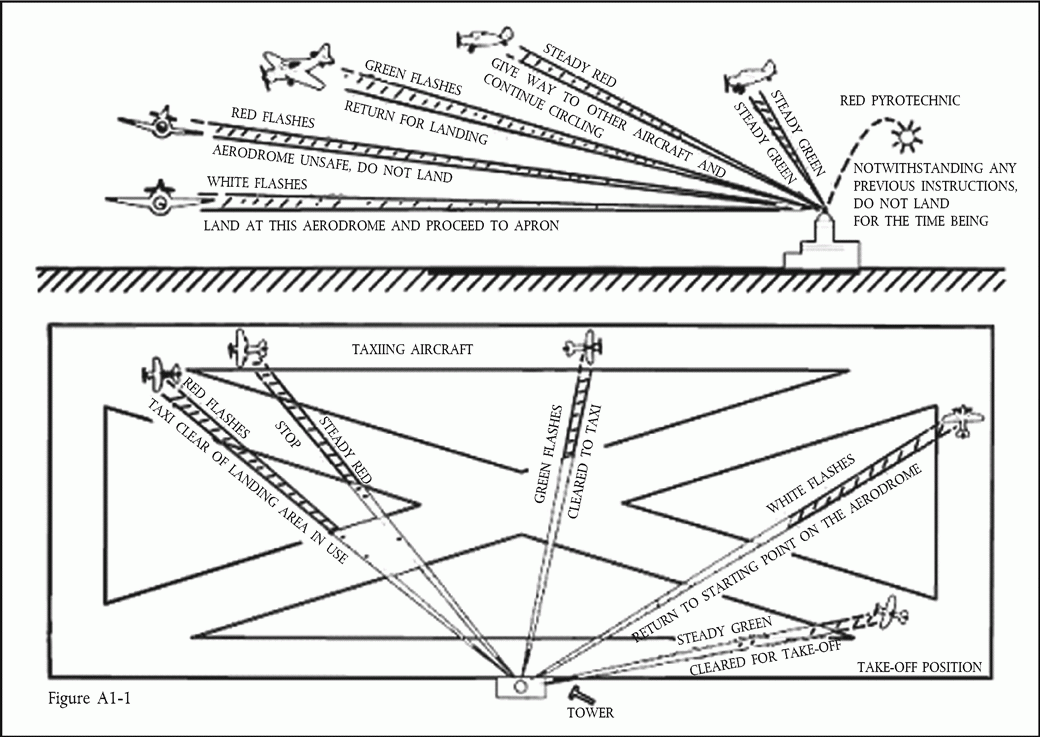
3.1.2. Acknowledgement by an aircraft
(a) When in flight:
-
by rocking the aircraft’s wings, except for the base and final legs of the approach;
-
by flashing on and off twice the aircraft’s landing lights or, if not so equipped, by switching on and off twice its navigation lights.
(b) When on the ground:
-
by moving the aircraft’s ailerons or rudder;
-
by flashing on and off twice the aircraft’s landing lights or, if not so equipped, by switching on and off twice its navigation lights.
3.2. Visual ground signals
3.2.1. Prohibition of landing
3.2.1.1.A horizontal red square panel with yellow diagonals (Figure A1-2) when displayed in a signal area indicates that landings are prohibited and that the prohibition is liable to be prolonged.


3.2.2.1.A horizontal red square panel with one yellow diagonal (Figure A1-3) when displayed in a signal area indicates that owing to the bad state of the manoeuvring area, or for any other reason, special precautions must be observed in approaching to land or in landing.
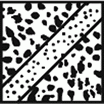

3.2.3.1.A horizontal white dumb-bell (Figure A1-4) when displayed in a signal area indicates that aircraft are required to land, take off and taxi on runways and taxiways only.




3.2.4.1. Crosses of a single contrasting colour, white on runways and yellow on taxiways (Figure A1-6), displayed horizontally on runways and taxiways or parts thereof indicate an area unfit for movement of aircraft.


3.2.5.1.A horizontal white or orange landing T (Figure A1-7) indicates the direction to be used by aircraft for landing and take-off, which shall be in a direction parallel to the shaft of the T towards the cross arm. When used at night, the landing T shall be either illuminated or outlined in white lights.




3.2.6.1.When displayed in a signal area, or horizontally at the end of the runway or strip in use, a right-hand arrow of conspicuous colour (Figure A1-9) indicates that turns are to be made to the right before landing and after take-off.


3.2.7.1.The letter C displayed vertically in black against a yellow background (Figure A1-10) indicates the location of the air traffic services reporting office.


3.2.8.1.A double white cross displayed horizontally (Figure A1-11) in the signal area indicates that the aerodrome is being used by sailplanes and that sailplane flights are being performed.


4.1. From a signalman/marshaller to an aircraft
4.1.1.The signals for use by the signalman/marshaller, with hands illuminated as necessary to facilitate observation by the pilot, and facing the aircraft in a position shall be:
- for fixed-wing aircraft, on left side of aircraft, where best seen by the pilot; and
- for helicopters, where the signalman/marshaller can best be seen by the pilot.
4.1.2.Prior to using the following signals, the signalman/marshaller shall ascertain that the area within which an aircraft is to be guided is clear of objects which the aircraft, in complying with SERA.3301(a), might otherwise strike.
|
a This signal provides an indication by a person positioned at the aircraft wing tip, to the pilot/marshaller/push-back operator, that the aircraft movement on/off a parking position would be unobstructed.
|
|
|
b This signal is also used as a technical/servicing communication signal.
|
|
|
c For use to hovering helicopters.
|
|
|
d This signal is intended mainly for aircraft with the set of integral stairs at the front.
|
|
 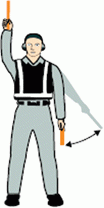 |
1. Wingwalker/guide aRaise right hand above head level with wand pointing up; move left-hand wand pointing down toward body. |
 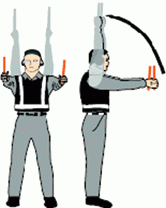 |
2. Identify gateRaise fully extended arms straight above head with wands pointing up. |
 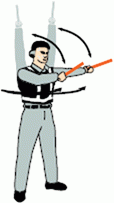 |
3. Proceed to next signalman/marshaller or as directed by tower/ground controlPoint both arms upward; move and extend arms outward to sides of body and point with wands to direction of next signalman/marshaller or taxi area. |
 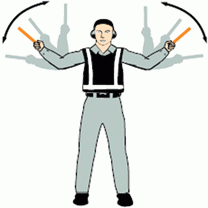 |
4. Straight aheadBend extended arms at elbows and move wands up and down from chest height to head. |
 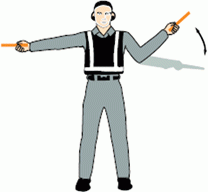 |
5(a) Turn left (from pilot’s point of view)With right arm and wand extended at a 90-degree angle to body, make ‘come ahead’ signal with left hand. The rate of signal motion indicates to pilot the rate of aircraft turn. |
  |
5(b) Turn right (from pilot’s point of view)With left arm and wand extended at a 90-degree angle to body, make ‘come ahead’ signal with right hand. The rate of signal motion indicates to pilot the rate of aircraft turn. |
 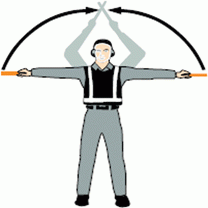 |
6(a) Normal stopFully extend arms and wands at a 90-degree angle to sides and slowly move to above head until wands cross. |
 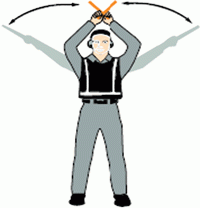 |
6(b) Emergency stopAbruptly extend arms and wands to top of head, crossing wands. |
 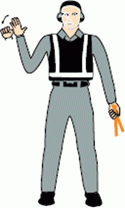 |
7(a) Set brakesRaise hand just above shoulder height with open palm. Ensuring eye contact with flight crew, close hand into a fist. Do not move until receipt of ‘thumbs up’ acknowledgement from flight crew. |
 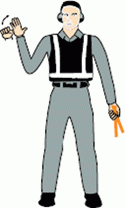 |
7(b) Release brakesRaise hand just above shoulder height with hand closed in a fist. Ensuring eye contact with flight crew, open palm. Do not move until receipt of ‘thumbs up’ acknowledgement from flight crew. |
  |
8(a) Chocks insertedWith arms and wands fully extended above head, move wands inward in a ‘jabbing’ motion until wands touch. Ensure acknowledgement is received from flight crew. |
  |
8(b) Chocks removedWith arms and wands fully extended above head, move wands outward in a ‘jabbing’ motion. Do not remove chocks until authorised by flight crew. |
  |
9. Start engine(s)Raise right arm to head level with wand pointing up and start a circular motion with hand; at the same time, with left arm raised above head level, point to engine to be started. |
 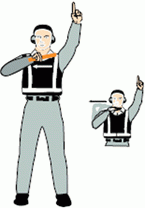 |
10. Cut enginesExtend arm with wand forward of body at shoulder level; move hand and wand to top of left shoulder and draw wand to top of right shoulder in a slicing motion across throat. |
 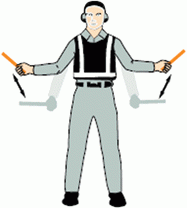 |
11. Slow downMove extended arms downwards in a ‘patting’ gesture, moving wands up and down from waist to knees. |
 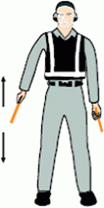 |
12. Slow down engine(s) on indicated sideWith arms down and wands toward ground, wave either right or left wand up and down indicating engine(s) on left or right side respectively should be slowed down. |
  |
13. Move backWith arms in front of body at waist height, rotate arms in a forward motion. To stop rearward movement, use signal 6(a) or 6(b). |
 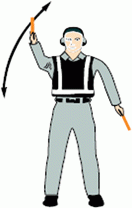 |
14(a) Turns while backing (for tail to starboard)Point left arm with wand down and bring right arm from overhead vertical position to horizontal forward position, repeating right-arm movement. |
 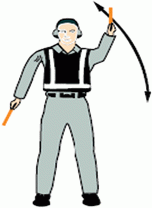 |
14(b) Turns while backing (for tail to port)Point right arm with wand down and bring left arm from overhead vertical position to horizontal forward position, repeating left-arm movement. |
 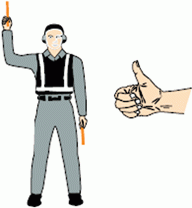 |
15. Affirmative/all clear bRaise right arm to head level with wand pointing up or display hand with ‘thumbs up’; left arm remains at side by knee. |
 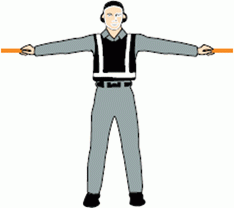 |
16. Hover cFully extend arms and wands at a 90-degree angle to sides. |
 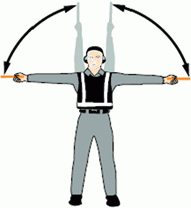 |
17. Move upwards cFully extend arms and wands at a 90-degree angle to sides and, with palms turned up, move hands upwards. Speed of movement indicates rate of ascent. |
 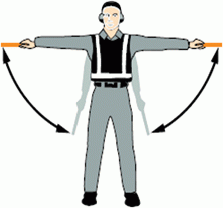 |
18. Move downwards cFully extend arms and wands at a 90-degree angle to sides and, with palms turned down, move hands downwards. Speed of movement indicates rate of descent. |
 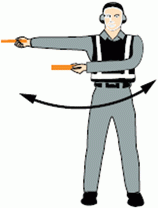 |
19(a) Move horizontally left (from pilot’s point of view) cExtend arm horizontally at a 90-degree angle to right side of body. Move other arm in same direction in a sweeping motion. |
 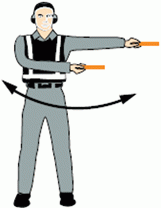 |
19(b) Move horizontally right (from pilot’s point of view) cExtend arm horizontally at a 90-degree angle to left side of body. Move other arm in same direction in a sweeping motion. |
  |
20. Land cCross arms with wands downwards and in front of body. |
 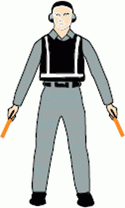 |
21. Hold position/stand byFully extend arms and wands downwards at a 45-degree angle to sides. Hold position until aircraft is clear for next manoeuvre. |
  |
22. Dispatch aircraftPerform a standard salute with right hand and/or wand to dispatch the aircraft. Maintain eye contact with flight crew until aircraft has begun to taxi. |
 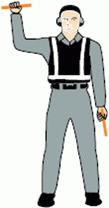 |
23. Do not touch controls (technical/servicing communication signal)Extend right arm fully above head and close fist or hold wand in horizontal position; left arm remains at side by knee. |
 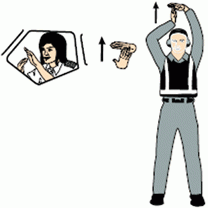 |
24. Connect ground power (technical/servicing communication signal)Hold arms fully extended above head; open left hand horizontally and move finger tips of right hand into and touch open palm of left hand (forming a ‘T’). At night, illuminated wands can also be used to form the ‘T’ above head. |
 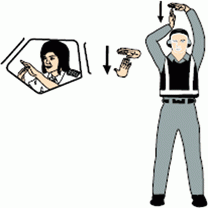 |
25. Disconnect power (technical/servicing communication signal)Hold arms fully extended above head with finger tips of right hand touching open horizontal palm of left hand (forming a ‘T’); then move right hand away from the left. Do not disconnect power until authorised by flight crew. At night, illuminated wands can also be used to form the ‘T’ above head. |
 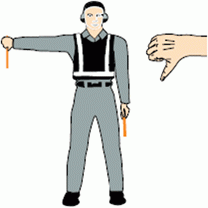 |
26. Negative (technical/servicing communication signal)Hold right arm straight out at 90 degrees from shoulder and point wand down to ground or display hand with ‘thumbs down’; left hand remains at side by knee. |
 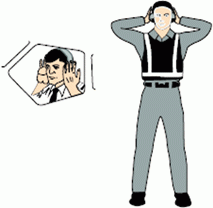 |
27. Establish communication via interphone (technical/servicing communication signal)Extend both arms at 90 degrees from body and move hands to cup both ears. |
 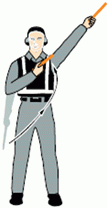 |
28. Open/close stairs (technical/servicing communication signal) dWith right arm at side and left arm raised above head at a 45-degree angle, move right arm in a sweeping motion towards top of left shoulder. |
4.2. From the pilot of an aircraft to a signalman/marshaller
4.2.1.These signals shall be used by a pilot in the cockpit with hands plainly visible to the signalman/marshaller, and illuminated as necessary to facilitate observation by the signalman/marshaller.
|
|
(a) Brakes engaged: raise arm and hand, with fingers extended, horizontally in front of face, then clench fist. |
|
|
(b) Brakes released: raise arm, with fist clenched, horizontally in front of face, then extend fingers. |
|
|
(c) Insert chocks: arms extended, palms outwards, move hands inwards to cross in front of face. |
|
|
(d) Remove chocks: hands crossed in front of face, palms outwards, move arms outwards. |
|
|
(e) Ready to start engine(s): Raise the appropriate number of fingers on one hand indicating the number of the engine to be started. |
4.3. Technical/servicing communication signals
4.3.1.Manual signals shall only be used when verbal communication is not possible with respect to technical/servicing communication signals.
4.3.2.Signalmen/marshallers shall ensure that an acknowledgement is received from the flight crew with respect to technical/servicing communication signals.
5.STANDARD EMERGENCY HAND SIGNALS
5.1.The following hand signals are established as the minimum required for emergency communication between the ARFF incident commander/ARFF firefighters and the cockpit and/or cabin crews of the incident aircraft. ARFF emergency hand signals should be given from the left front side of the aircraft for the cockpit crew.
 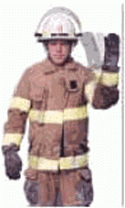 |
1. Recommend evacuationEvacuation recommended based on aircraft rescue and fire-fighting and Incident Commander’s assessment of external situation. Arm extended from body, and held horizontal with hand upraised at eye level. Execute beckoning arm motion angled backward. Non-beckoning arm held against body. Night — same with wands. |
  |
2. Recommend stopRecommend evacuation in progress be halted. Stop aircraft movement or other activity in progress. Arms in front of head — Crossed at wrists Night — same with wands. |
 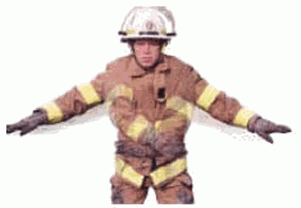 |
3. Emergency containedNo outside evidence of dangerous conditions or ‘all-clear.’ Arms extended outward and down at a 45 degree angle. Arms moved inward below waistline simultaneously until wrists crossed, then extended outward to starting position. |
  |
4. FireMove right-hand in a ‘fanning’ motion from shoulder to knee, while at the same time pointing with left hand to area of fire. Night — same with wands. |
Appendix 2
Unmanned free balloons
1.CLASSIFICATION OF UNMANNED FREE BALLOONS
1.1. Unmanned free balloons shall be classified as (see Figure AP2-1):
- light:an unmanned free balloon which carries a payload of one or more packages with a combined mass of less than 4 kg, unless qualifying as a heavy balloon in accordance with (c)(2),(3) or (4); or
- medium:an unmanned free balloon which carries a payload of two or more packages with a combined mass of 4 kg or more, but less than 6 kg, unless qualifying as a heavy balloon in accordance with (c)(2), (3) or (4) below; or
- heavy:an unmanned free balloon which carries a payload which:
2.GENERAL OPERATING RULES
2.1.An unmanned free balloon shall not be operated without authorisation from the State from which the launch is made.
2.2.An unmanned free balloon, other than a light balloon used exclusively for meteorological purposes and operated in the manner prescribed by the competent authority, shall not be operated across the territory of another State without authorisation from the other State concerned.
2.3.The authorisation referred to in 2.2 shall be obtained prior to the launching of the balloon if there is reasonable expectation, when planning the operation, that the balloon may drift into airspace over the territory of another State. Such authorisation may be obtained for a series of balloon flights or for a particular type of recurring flight, e.g. atmospheric research balloon flights.
2.4.An unmanned free balloon shall be operated in accordance with conditions specified by the State of Registry and the State(s) expected to be overflown.
2.5.An unmanned free balloon shall not be operated in such a manner that impact of the balloon, or any part thereof, including its payload, with the surface of the earth, creates a hazard to persons or property.
2.6.A heavy unmanned free balloon shall not be operated over the high seas without prior coordination with the ANSP(s).
Figure AP2-1
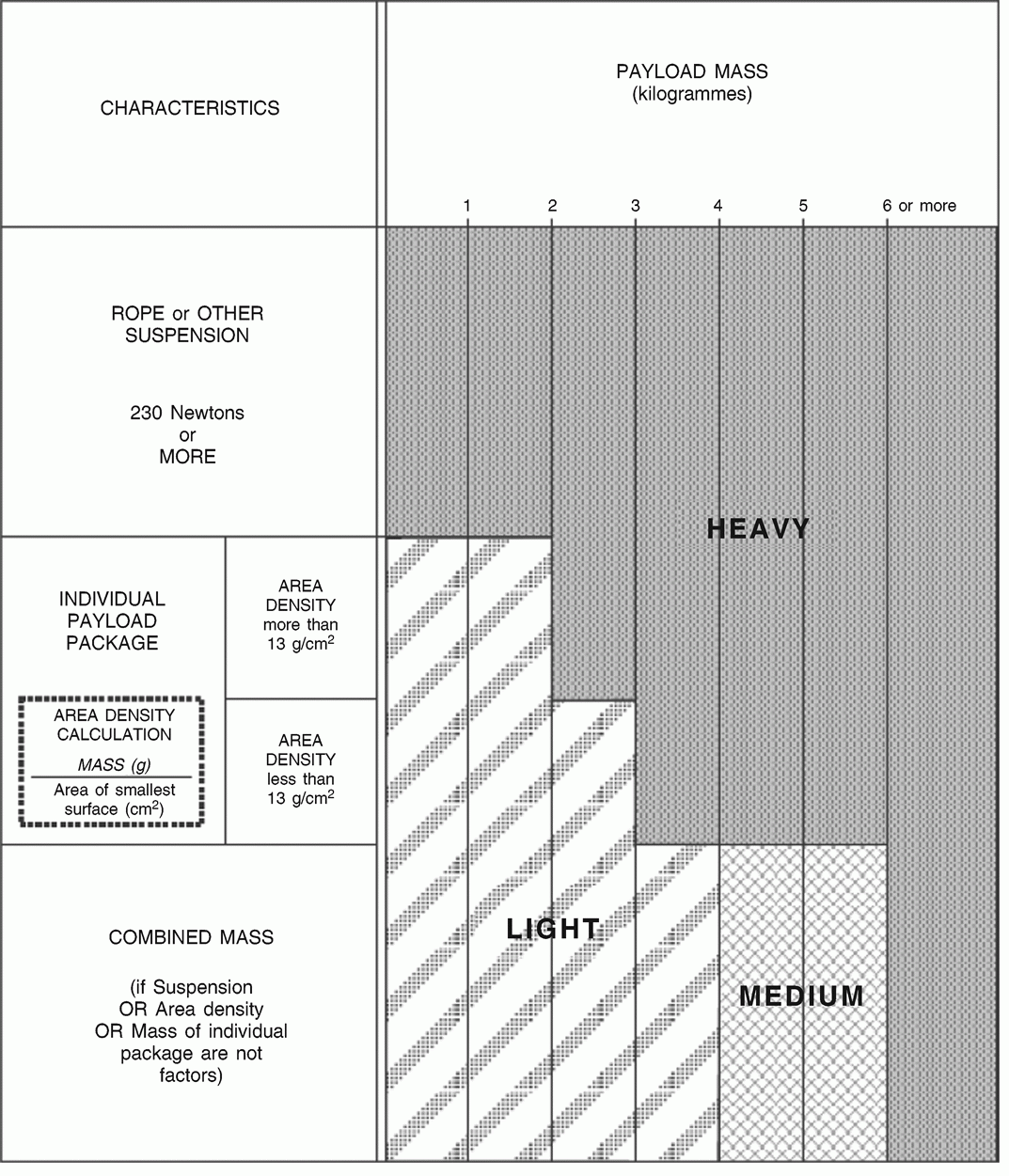
3.OPERATING LIMITATIONS AND EQUIPMENT REQUIREMENTS
3.1.A heavy unmanned free balloon shall not be operated without authorisation from the ANSP(s) at or through any level below 18 000 m (60 000 ft) pressure-altitude at which:
- there are clouds or obscuring phenomena of more than four oktas coverage; or
- the horizontal visibility is less than 8 km.
3.2.A heavy or medium unmanned free balloon shall not be released in a manner that will cause it to fly lower than 300 m (1 000 ft) over the congested areas of cities, towns or settlements or an open-air assembly of persons not associated with the operation.
3.3.A heavy unmanned free balloon shall not be operated unless:
- it is equipped with at least two payload flight-termination devices or systems, whether automatic or operated by telecommand, that operate independently of each other;
- for polyethylene zero-pressure balloons, at least two methods, systems, devices, or combinations thereof, that function independently of each other are employed for terminating the flight of the balloon envelope;
- the balloon envelope is equipped with either a radar reflective device(s) or radar reflective material that will present an echo to surface radar operating in the 200 MHz to 2 700 MHz frequency range, and/or the balloon is equipped with such other devices as will permit continuous tracking by the operator beyond the range of ground-based radar.
3.4.A heavy unmanned free balloon shall not be operated under the following conditions:
- in an area where ground-based SSR equipment is in use, unless it is equipped with a secondary surveillance radar transponder, with pressure-altitude reporting capability, which is continuously operating on an assigned code, or which can be turned on when necessary by the tracking station; or
- in an area where ground-based ADS-B equipment is in use, unless it is equipped with an ADS-B transmitter, with pressure-altitude reporting capability, which is continuously operating or which can be turned on when necessary by the tracking station.
3.5.An unmanned free balloon that is equipped with a trailing antenna that requires a force of more than 230 N to break it at any point shall not be operated unless the antenna has coloured pennants or streamers that are attached at not more than 15 m intervals.
3.6.A heavy unmanned free balloon shall not be operated below 18 000 m (60 000 ft) pressure-altitude at night or during any other period prescribed by the competent authority, unless the balloon and its attachments and payload, whether or not they become separated during the operation, are lighted.
3.7.A heavy unmanned free balloon that is equipped with a suspension device (other than a highly conspicuously coloured open parachute) more than 15 m long shall not be operated during night below 18 000 m (60 000 ft) pressure-altitude unless the suspension device is coloured in alternate bands of high conspicuity colours or has coloured pennants attached.
4.TERMINATION
4.1.The operator of a heavy unmanned free balloon shall activate the appropriate termination devices required by 3.3(a) and (b):
- when it becomes known that weather conditions are less than those prescribed for the operation;
- if a malfunction or any other reason makes further operation hazardous to air traffic or to persons or property on the surface; or
- prior to unauthorised entry into the airspace over another State’s territory.
5.FLIGHT NOTIFICATION
5.1. Pre-flight notification
5.1.1.Early notification of the intended flight of an unmanned free balloon in the medium or heavy category shall be made to the appropriate air traffic services unit not less than seven days before the date of the intended flight.
5.1.2.Notification of the intended flight shall include such of the following information as may be required by the appropriate air traffic services unit:
- balloon flight identification or project code name;
- balloon classification and description;
- SSR code, aircraft address or NDB frequency as applicable;
- operator’s name and telephone number;
- launch site;
- estimated time of launch (or time of commencement and completion of multiple launches);
- number of balloons to be launched and the scheduled interval between launches (if multiple launches);
- expected direction of ascent;
- cruising level(s) (pressure-altitude);
- the estimated elapsed time to pass 18 000 m (60 000 ft) pressure-altitude or to reach cruising level if at or below 18 000 m (60 000 ft), together with the estimated location. If the operation consists of continuous launchings, the time to be included shall be the estimated time at which the first and the last in the series will reach the appropriate level (e.g. 122136Z–130330Z);
- the estimated date and time of termination of the flight and the planned location of the impact/recovery area. In the case of balloons carrying out flights of long duration, as a result of which the date and time of termination of the flight and the location of impact cannot be forecast with accuracy, the term ‘long duration’ shall be used. If there is to be more than one location of impact/recovery, each location shall be listed together with the appropriate estimated time of impact. If there is to be a series of continuous impacts, the time to be included shall be the estimated time of the first and the last in the series (e.g. 070330Z–072300Z).
5.1.3. Any changes in the pre-launch information notified in accordance with point 5.1.2 shall be forwarded to the ATS unit concerned not less than 6 hours before the estimated time of launch, or in the case of solar or cosmic disturbance investigations involving a critical time element, not less than 30 minutes before the estimated time of the commencement of the operation.
5.2. Notification of launch
5.2.1.Immediately after a medium or heavy unmanned free balloon is launched the operator shall notify the appropriate air traffic services unit of the following:
- balloon flight identification;
- launch site;
- actual time of launch;
- estimated time at which 18 000 m (60 000 ft) pressure-altitude will be passed, or the estimated time at which the cruising level will be reached if at or below 18 000 m (60 000 ft), and the estimated location; and
- any changes to the information previously notified in accordance with 5.1.2(g) and (h).
5.3. Notification of cancellation
5.3.1.The operator shall notify the appropriate air traffic services unit immediately it is known that the intended flight of a medium or heavy unmanned free balloon, previously notified in accordance with paragraph 5.1, has been cancelled.
6.POSITION RECORDING AND REPORTS
6.1.The operator of a heavy unmanned free balloon operating at or below 18 000 m (60 000 ft) pressure-altitude shall monitor the flight path of the balloon and forward reports of the balloon’s position as requested by air traffic services. Unless air traffic services require reports of the balloon’s position at more frequent intervals, the operator shall record the position every 2 hours.
6.2.The operator of a heavy unmanned free balloon operating above 18 000 m (60 000 ft) pressure-altitude shall monitor the flight progress of the balloon and forward reports of the balloon’s position as requested by air traffic services. Unless air traffic services require reports of the balloon’s position at more frequent intervals, the operator shall record the position every 24 hours.
6.3.If a position cannot be recorded in accordance with 6.1 and 6.2, the operator shall immediately notify the appropriate air traffic services unit. This notification shall include the last recorded position. The appropriate air traffic services unit shall be notified immediately when tracking of the balloon is re-established.
6.4.One hour before the beginning of planned descent of a heavy unmanned free balloon, the operator shall forward to the appropriate ATS unit the following information regarding the balloon:
- the current geographical position;
- the current level (pressure-altitude);
- the forecast time of penetration of 18 000 m (60 000 ft) pressure-altitude, if applicable;
- the forecast time and location of ground impact.
6.5.The operator of a heavy or medium unmanned free balloon shall notify the appropriate air traffic services unit when the operation is ended.
Appendix 3
Table of cruising levels
1.1.The cruising levels to be observed are as follows:
|
a Magnetic track, or in polar areas at latitudes higher than 70 degrees and within such extensions to those areas as may be prescribed by the competent authorities, grid tracks as determined by a network of lines parallel to the Greenwich Meridian superimposed on a polar stereographic chart in which the direction towards the North Pole is employed as the Grid North.
|
|||||||||||
| TRACKa | |||||||||||
| From 000 degrees to 179 degrees | From 180 degrees to 359 degrees | ||||||||||
| IFR Flights | VFR Flights | IFR Flights | VFR Flights | ||||||||
| Level | Level | Level | Level | ||||||||
| FL | Feet | Metres | FL | Feet | Metres | FL | Feet | Metres | FL | Feet | Metres |
| 010 | 1 000 | 300 | — | — | — | 020 | 2 000 | 600 | — | — | — |
| 030 | 3 000 | 900 | 035 | 3 500 | 1 050 | 040 | 4 000 | 1 200 | 045 | 4 500 | 1 350 |
| 050 | 5 000 | 1 500 | 055 | 5 500 | 1 700 | 060 | 6 000 | 1 850 | 065 | 6 500 | 2 000 |
| 070 | 7 000 | 2 150 | 075 | 7 500 | 2 300 | 080 | 8 000 | 2 450 | 085 | 8 500 | 2 600 |
| 090 | 9 000 | 2 750 | 095 | 9 500 | 2 900 | 100 | 10 000 | 3 050 | 105 | 10 500 | 3 200 |
| 110 | 11 000 | 3 350 | 115 | 11 500 | 3 500 | 120 | 12 000 | 3 650 | 125 | 12 500 | 3 800 |
| 130 | 13 000 | 3 950 | 135 | 13 500 | 4 100 | 140 | 14 000 | 4 250 | 145 | 14 500 | 4 400 |
| 150 | 15 000 | 4 550 | 155 | 15 500 | 4 700 | 160 | 16 000 | 4 900 | 165 | 16 500 | 5 050 |
| 170 | 17 000 | 5 200 | 175 | 17 500 | 5 350 | 180 | 18 000 | 5 500 | 185 | 18 500 | 5 650 |
| 190 | 19 000 | 5 800 | 195 | 19 500 | 5 950 | 200 | 20 000 | 6 100 | 205 | 20 500 | 6 250 |
| 210 | 21 000 | 6 400 | 215 | 21 500 | 6 550 | 220 | 22 000 | 6 700 | 225 | 22 500 | 6 850 |
| 230 | 23 000 | 7 000 | 235 | 23 500 | 7 150 | 240 | 24 000 | 7 300 | 245 | 24 500 | 7 450 |
| 250 | 25 000 | 7 600 | 255 | 25 500 | 7 750 | 260 | 26 000 | 7 900 | 265 | 26 500 | 8 100 |
| 270 | 27 000 | 8 250 | 275 | 27 500 | 8 400 | 280 | 28 000 | 8 550 | 285 | 28 500 | 8 700 |
| 290 | 29 000 | 8 850 | 300 | 30 000 | 9 150 | ||||||
| 310 | 31 000 | 9 450 | 320 | 32 000 | 9 750 | ||||||
| 330 | 33 000 | 10 050 | 340 | 34 000 | 10 350 | ||||||
| 350 | 35 000 | 10 650 | 360 | 36 000 | 10 950 | ||||||
| 370 | 37 000 | 11 300 | 380 | 38 000 | 11 600 | ||||||
| 390 | 39 000 | 11 900 | 400 | 40 000 | 12 200 | ||||||
| 410 | 41 000 | 12 500 | 430 | 43 000 | 13 100 | ||||||
| 450 | 45 000 | 13 700 | 470 | 47 000 | 14 350 | ||||||
| 490 | 49 000 | 14 950 | 510 | 51 000 | 15 550 | ||||||
| etc. | etc. | etc. etc. | etc. | etc. | etc. | ||||||
Appendix 4
ATS airspace classes — services provided and flight requirements
(SERA.6001 and SERA.5025(b) refers)
|
a When the level of the transition altitude is lower than 3 050 m (10 000 ft) AMSL, FL 100 should be used in lieu of 10 000 ft. Competent authority may also exempt aircraft types, which for technical or safety reasons, cannot maintain this speed.
|
|||||||
|
b Pilots shall maintain continuous air-ground voice communication watch and establish two-way communication, as necessary, on the appropriate communication channel in RMZ.
|
|||||||
|
c Air-ground voice communications mandatory for flights participating in the advisory service. Pilots shall maintain continuous air-ground voice communication watch and establish two-way communication, as necessary, on the appropriate communication channel in RMZ.
|
|||||||
| Class | Type of flight | Separation provided | Service provided | Speed limitationa | Radio communication capability requirement | Continuous two-way air-ground voice communication required | Subject to an ATC clearance |
| A | IFR only | All aircraft | Air traffic control service | Not applicable | Yes | Yes | Yes |
| B | IFR | All aircraft | Air traffic control service | Not applicable | Yes | Yes | Yes |
| VFR | All aircraft | Air traffic control service | Not applicable | Yes | Yes | Yes | |
| C | IFR |
IFR from IFR IFR from VFR |
Air traffic control service | Not applicable | Yes | Yes | Yes |
| VFR | VFR from IFR |
(1)
Air traffic control service for separation from IFR; (2)
[F3Air traffic control service, VFR/VFR traffic information (and traffic avoidance advice on request)] |
250 kts IAS below 3 050 m (10 000 ft) AMSL |
Yes | Yes | Yes | |
| D | IFR | IFR from IFR |
Air traffic control service, traffic information about VFR flights (and traffic avoidance advice on request) |
250 kts IAS below 3 050 m (10 000 ft) AMSL |
Yes | Yes | Yes |
| VFR | Nil | [F3Air traffic control service, IFR/VFR and VFR/VFR traffic information (and traffic avoidance advice on request)] |
250 kts IAS below 3 050 m (10 000 ft) AMSL |
Yes | Yes | Yes | |
| E | IFR | IFR from IFR | Air traffic control service and, as far as practical, traffic information about VFR flights |
250 kts IAS below 3 050 m (10 000 ft) AMSL |
Yes | Yes | Yes |
| VFR | Nil | Traffic information as far as practical |
250 kts IAS below 3 050 m (10 000 ft) AMSL |
Nob | Nob | No | |
| F | IFR | IFR from IFR as far as practical | Air traffic advisory service; flight information service if requested |
250 kts IAS below 3 050 m (10 000 ft) AMSL |
Yesc | Noc | No |
| VFR | Nil | Flight information service if requested |
250 kts IAS below 3 050 m (10 000 ft) AMSL |
Nob | Nob | No | |
| G | IFR | Nil | Flight information service if requested |
250 kts IAS below 3 050 m (10 000 ft) AMSL |
Yesb | Nob | No |
| VFR | Nil | Flight information service if requested |
3 050 m (10 000 ft) AMSL |
Nob | Nob | No | |
Appendix 5
Technical specifications related to aircraft observations and reports by voice communications
A. REPORTING INSTRUCTIONS
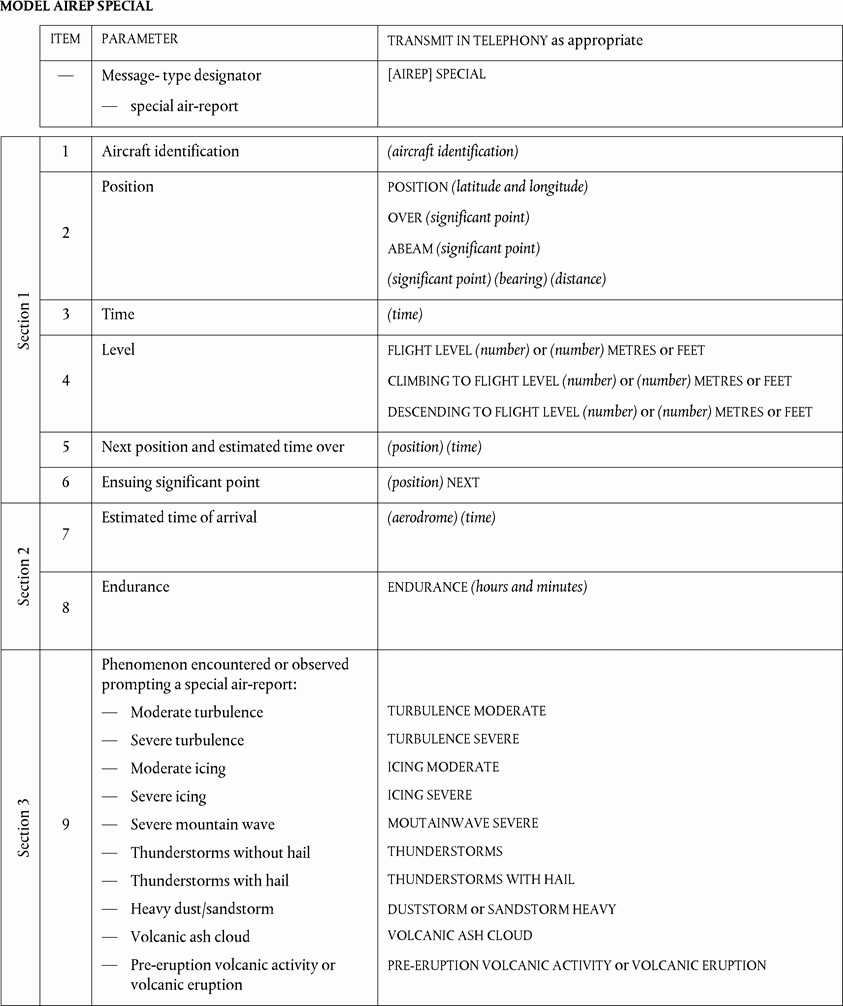

1.1. Position reports and special air-reports
1.1.1. Section 1 of the model set out in point A is obligatory for position reports and special air-reports, although Items 5 and 6 thereof may be omitted. Section 2 shall be added, in whole or in part, only when so requested by the operator or its designated representative, or when deemed necessary by the pilot-in-command. Section 3 shall be included in special air-reports.
1.1.2. Condition prompting the issuance of a special air-report are to be selected from the list presented in point SERA.12005(a).
1.1.3. In the case of special air-reports containing information on volcanic activity, a post-flight report shall be made using the volcanic activity reporting form (Model VAR) set out in point B. All elements which are observed shall be recorded and indicated respectively in the appropriate places on the form Model VAR.
1.1.4. Special air-reports shall be issued as soon as practicable after a phenomenon calling for a special air-report has been observed.
2. DETAILED REPORTING INSTRUCTIONS
2.1. Items of an air-report shall be reported in the order in which they are listed in the model AIREP SPECIAL form.
-
MESSAGE TYPE DESIGNATOR. Report ‘ SPECIAL ’ for a special air-report.
Section 1
Item 1 — AIRCRAFT IDENTIFICATION. Report the aircraft radiotelephony call sign as prescribed in point SERA.14050.
Item 2 — POSITION. Report position in latitude (degrees as 2 numerics or degrees and minutes as 4 numerics, followed by ‘North’ or ‘South’) and longitude (degrees as 3 numerics or degrees and minutes as 5 numerics followed by ‘East’ or ‘West’), or as a significant point identified by a coded designator (2 to 5 characters), or as a significant point followed by magnetic bearing (3 numerics) and distance in nautical miles from the point. Precede significant point with ‘ABEAM’, if applicable.
Item 3 — TIME. Report time in hours and minutes UTC (4 numerics) unless reporting time in minutes past the hour (2 numerics) is prescribed on the basis of regional air navigation agreements. The time reported must be the actual time of the aircraft at the position and not the time of origination or transmission of the report. Time shall always be reported in hours and minutes UTC when issuing a special air-report.
Item 4 — FLIGHT LEVEL OR ALTITUDE. Report flight level by 3 numerics when on standard pressure altimeter setting. Report altitude in metres followed by ‘METRES’ or in feet followed by ‘FEET’ when on QNH. Report ‘CLIMBING’ (followed by the level) when climbing or ‘DESCENDING’ (followed by the level) when descending to a new level after passing the significant point.
Item 5 — NEXT POSITION AND ESTIMATED TIME OVER. Report the next reporting point and the estimated time over such reporting point, or report the estimated position that will be reached one hour later, according to the position reporting procedures in force. Use the data conventions specified in Item 2 for position. Report the estimated time over this position. Report time in hours and minutes UTC (4 numerics) unless reporting time in minutes past the hour (2 numerics) as prescribed by regional air navigation agreements.
Item 6 — ENSUING SIGNIFICANT POINT. Report the ensuing significant point following the ‘next position and estimated time over’.
Section 2
Item 7 — ESTIMATED TIME OF ARRIVAL. Report the name of the aerodrome of the first intended landing, followed by the estimated time of arrival at this aerodrome in hours and minutes UTC (4 numerics).
Item 8 — ENDURANCE. Report ‘ENDURANCE’ followed by fuel endurance in hours and minutes (4 numerics).
Section 3
Item 9 — PHENOMENON PROMPTING A SPECIAL AIR-REPORT. Report one of the following phenomena encountered or observed:
-
moderate turbulence as ‘ TURBULENCE MODERATE ’ , and
-
severe turbulence as ‘ TURBULENCE SEVERE ’ .
The following specifications apply:
— Moderate —Conditions in which moderate changes in aircraft attitude and/or altitude may occur but the aircraft remains in positive control at all times. Usually, small variations in airspeed. Changes in accelerometer readings of 0,5 g to 1,0 g at the aircraft's centre of gravity. Difficulty in walking. Occupants feel strain against seat belts. Loose objects move about.— Severe—Conditions in which abrupt changes in aircraft attitude and/or altitude occur; aircraft may be out of control for short periods. Usually, large variations in airspeed. Changes in accelerometer readings greater than 1,0 g at the aircraft's centre of gravity. Occupants are forced violently against seat belts. Loose objects are tossed about. -
moderate icing as ‘ ICING MODERATE ’ , severe icing as ‘ ICING SEVERE ’ ;
The following specifications apply:
— Moderate—Conditions in which change of heading and/or altitude may be considered desirable.— Severe—Conditions in which immediate change of heading and/or altitude is considered essential. -
Severe mountain wave as ‘ MOUNTAIN WAVE SEVERE ’ ;
The following specification applies:
— Severe—Conditions in which the accompanying downdraft is 3,0 m/s (600 ft/min) or more and/or severe turbulence is encountered. -
Thunderstorm without hail as ‘ THUNDERSTORM ’ , thunderstorm with hail as ‘ THUNDERSTORM WITH HAIL ’ ;
The following specification applies:
Only report those thunderstorms which are:
-
obscured in haze, or
-
embedded in cloud, or
-
widespread, or
-
forming a squall line.
-
-
Heavy duststorm or sandstorm as ‘ DUSTSTORM HEAVY ’ or ‘ SANDSTORM HEAVY ’ ;
-
Volcanic ash cloud as ‘ VOLCANIC ASH CLOUD ’ ;
-
Pre-eruption volcanic activity or a volcanic eruption as ‘ PRE-ERUPTION VOLCANIC ACTIVITY ’ or ‘ VOLCANIC ERUPTION ’ ;
The following specification applies:
‘ Pre-eruption volcanic activity ’ in this context means unusual and/or increasing volcanic activity which could presage a volcanic eruption.
2.2. Information recorded on the volcanic activity reporting form (Model VAR) is not for transmission by RTF but, on arrival at an aerodrome, is to be delivered without delay by the operator or a flight crew member to the aerodrome meteorological office. If such an office is not easily accessible, the completed form shall be delivered in accordance with local arrangements agreed upon between MET and ATS providers and the aircraft operator.
3. FORWARDING OF METEOROLOGICAL INFORMATION RECEIVED BY VOICE COMMUNICATIONS
When receiving special air-reports, ATS units shall forward these air-reports without delay to the associated meteorological watch office (MWO). In order to ensure assimilation of air-reports in ground-based automated systems, the elements of such reports shall be transmitted using the data conventions specified below and in the order prescribed.
-
ADDRESSEE. Record the station called and, when necessary, relay required.
-
MESSAGE TYPE DESIGNATOR. Record ‘ ARS ’ for a special air-report.
-
AIRCRAFT IDENTIFICATION. Record the aircraft identification using the data convention specified for Item 7 of the flight plan, without a space between the operator's designator and the aircraft registration or flight identification, if used.
Section 1
Item 0 — POSITION. Record position in latitude (degrees as 2 numerics or degrees and minutes as 4 numerics, followed, without a space, by N or S) and longitude (degrees as 3 numerics or degrees and minutes as 5 numerics, followed without a space by E or W), or as a significant point identified by a coded designator (2 to 5 characters), or as a significant point followed by magnetic bearing (3 numerics) and distance in nautical miles (3 numerics) from the point. Precede significant point with ‘ABEAM’, if applicable.
Item 1 — TIME. Record time in hours and minutes UTC (4 numerics).
Item 2 — FLIGHT LEVEL OR ALTITUDE. Record ‘F’ followed by 3 numerics (e.g. ‘F310’) when a flight level is reported. Record altitude in metres followed by ‘M’ or in feet followed by ‘FT’ when an altitude is reported. Record ‘ASC’ (level) when climbing or ‘DES’ (level) when descending.
Section 2
Item 9 — PHENOMENON PROMPTING A SPECIAL AIR-REPORT. Record the phenomenon reported as follows:
-
moderate turbulence as ‘ TURB MOD ’ ,
-
severe turbulence as ‘ TURB SEV ’ ,
-
moderate icing as ‘ ICE MOD ’ ,
-
severe icing as ‘ ICE SEV ’ ,
-
severe mountain wave as ‘ MTW SEV ’ ,
-
thunderstorm without hail as ‘ TS ’ ,
-
thunderstorm with hail as ‘ TSGR ’ ,
-
heavy duststorm or sandstorm as ‘ HVY SS ’ ,
-
volcanic ash cloud as ‘ VA CLD ’ ,
-
pre-eruption volcanic activity or a volcanic eruption as ‘ VA ’ ,
-
hail as ‘ GR ’ ,
-
cumulonimbus clouds as ‘ CB ’ .
TIME TRANSMITTED. Record only when Section 3 is transmitted.
4. SPECIFIC PROVISIONS RELATED TO REPORTING WIND SHEAR AND VOLCANIC ASH
4.1. Reporting of wind shear
4.1.1. When reporting aircraft observations of wind shear encountered during the climb-out and approach phases of flight, the aircraft type shall be included.
4.1.2. Where wind shear conditions in the climb-out or approach phases of flight were reported or forecast but not encountered, the pilot-in-command shall advise the appropriate ATS unit as soon as practicable unless the pilot-in-command is aware that the appropriate ATS unit has already been so advised by a preceding aircraft.
4.2. Post-flight reporting of volcanic activity
4.2.1. On arrival of a flight at an aerodrome, the completed report of volcanic activity shall be delivered by the aircraft operator or a flight crew member, without delay, to the aerodrome meteorological office, or if such office is not easily accessible to arriving flight crew members, the completed form shall be dealt with in accordance with local arrangements agreed upon between MET and ATS providers and the aircraft operator.
4.2.2. The completed report of volcanic activity received by an aerodrome meteorological office shall be transmitted without delay to the meteorological watch office responsible for the provision of meteorological watch for the flight information region in which the volcanic activity was observed.
B. SPECIAL AIR-REPORT OF VOLCANIC ACTIVITY FORM (MODEL VAR)
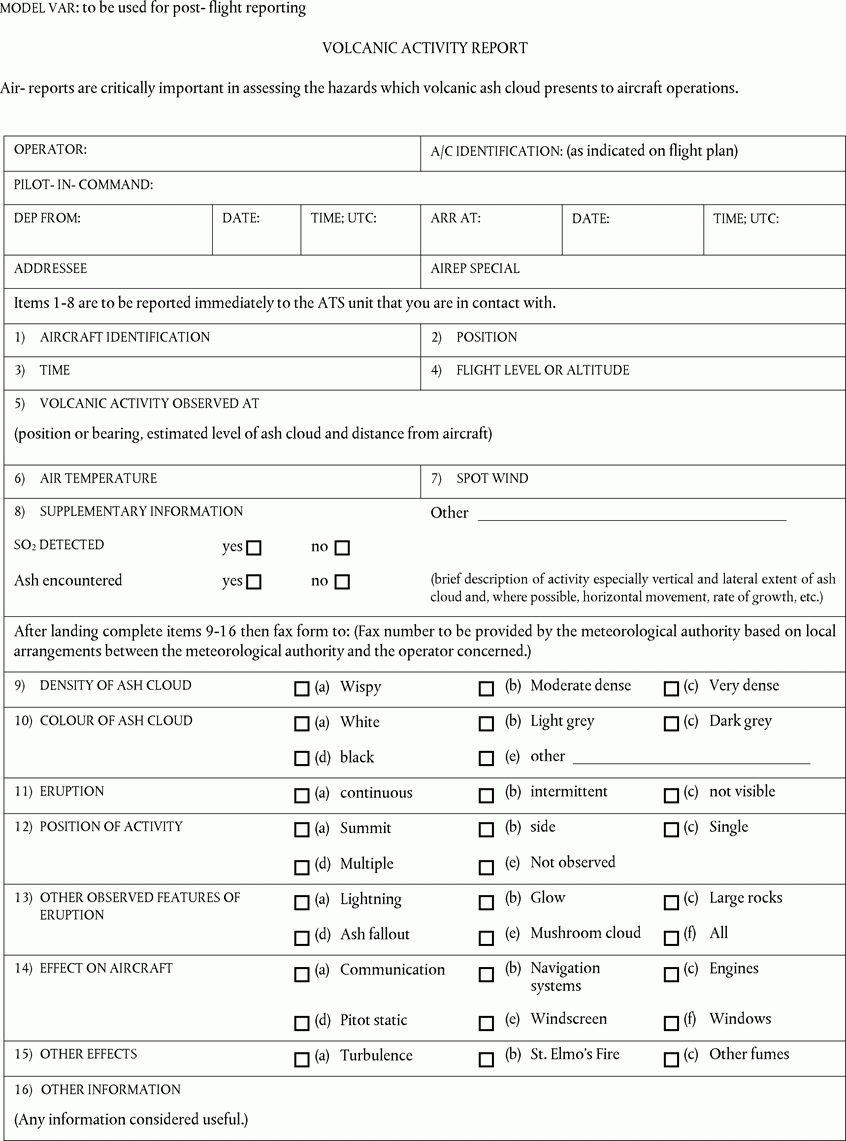
Omitted


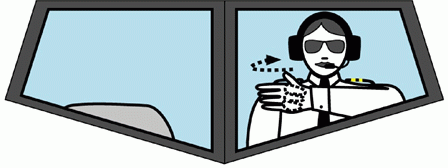
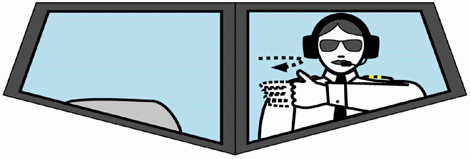
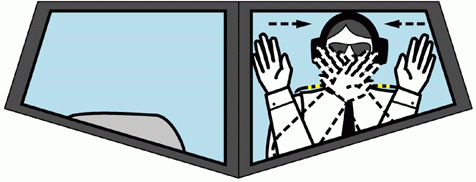
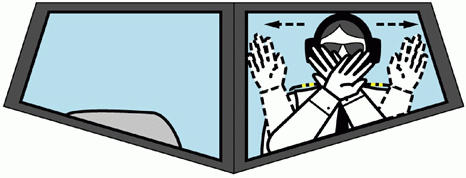
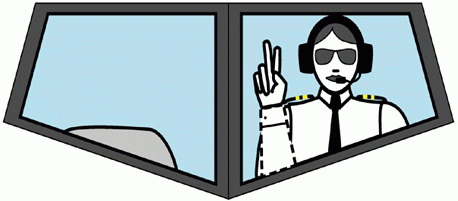

 Supplement to the ANNEX
Supplement to the ANNEX